Healthcare: Confirm Physical Health Status
VerifiedAdded on 2023/01/17
|20
|4305
|29
AI Summary
This document discusses various topics related to healthcare, including physical health status confirmation, causes of hypothermia, homeostasis, changes in the body, cellular adaptation, professions in a multidisciplinary team, atheroma formation, skin structure and function, type 2 diabetes, hyperlipidemia, and respiratory processes.
Contribute Materials
Your contribution can guide someone’s learning journey. Share your
documents today.

Running head: HEALTHCARE 1
Confirm Physical Health Status
Student Name
Institution
Confirm Physical Health Status
Student Name
Institution
Secure Best Marks with AI Grader
Need help grading? Try our AI Grader for instant feedback on your assignments.
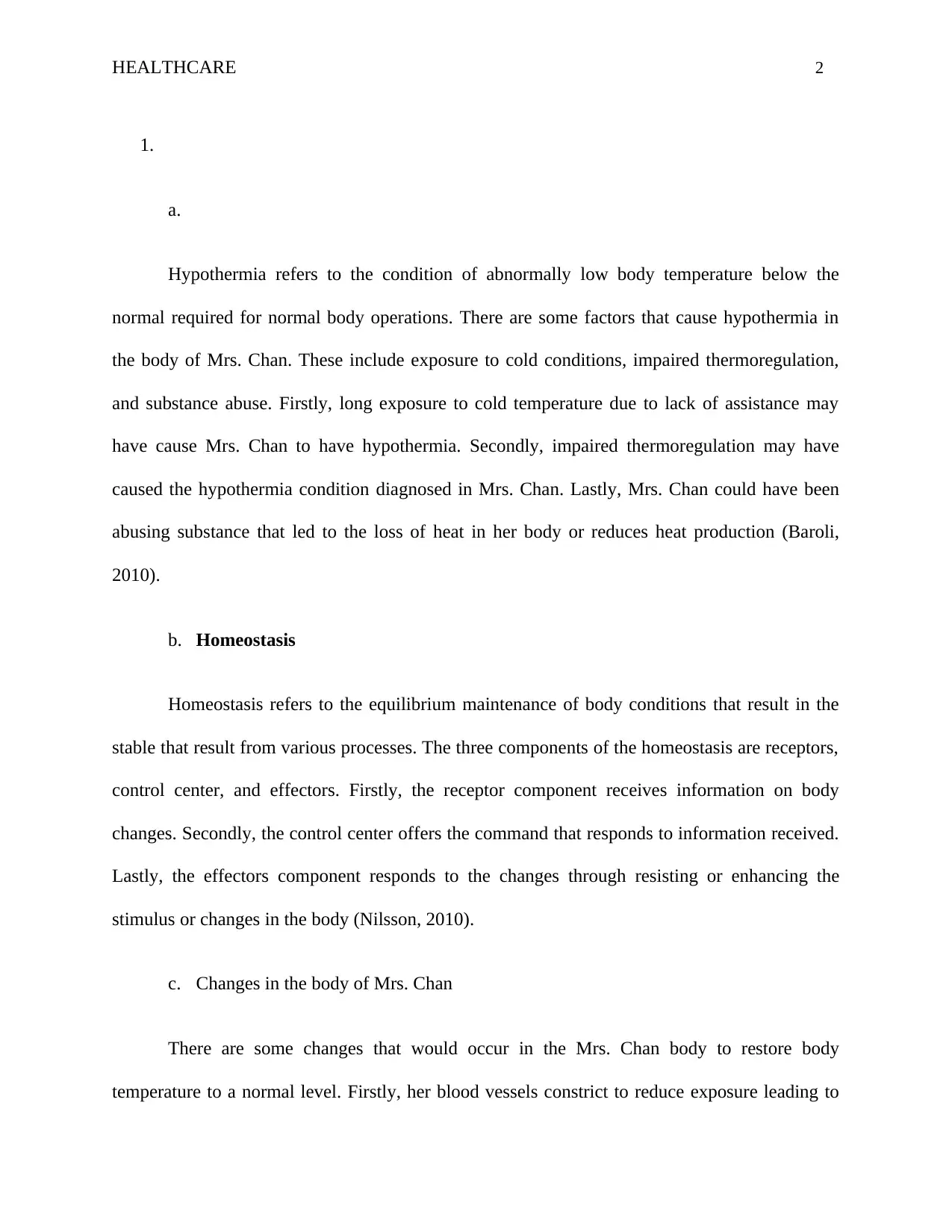
HEALTHCARE 2
1.
a.
Hypothermia refers to the condition of abnormally low body temperature below the
normal required for normal body operations. There are some factors that cause hypothermia in
the body of Mrs. Chan. These include exposure to cold conditions, impaired thermoregulation,
and substance abuse. Firstly, long exposure to cold temperature due to lack of assistance may
have cause Mrs. Chan to have hypothermia. Secondly, impaired thermoregulation may have
caused the hypothermia condition diagnosed in Mrs. Chan. Lastly, Mrs. Chan could have been
abusing substance that led to the loss of heat in her body or reduces heat production (Baroli,
2010).
b. Homeostasis
Homeostasis refers to the equilibrium maintenance of body conditions that result in the
stable that result from various processes. The three components of the homeostasis are receptors,
control center, and effectors. Firstly, the receptor component receives information on body
changes. Secondly, the control center offers the command that responds to information received.
Lastly, the effectors component responds to the changes through resisting or enhancing the
stimulus or changes in the body (Nilsson, 2010).
c. Changes in the body of Mrs. Chan
There are some changes that would occur in the Mrs. Chan body to restore body
temperature to a normal level. Firstly, her blood vessels constrict to reduce exposure leading to
1.
a.
Hypothermia refers to the condition of abnormally low body temperature below the
normal required for normal body operations. There are some factors that cause hypothermia in
the body of Mrs. Chan. These include exposure to cold conditions, impaired thermoregulation,
and substance abuse. Firstly, long exposure to cold temperature due to lack of assistance may
have cause Mrs. Chan to have hypothermia. Secondly, impaired thermoregulation may have
caused the hypothermia condition diagnosed in Mrs. Chan. Lastly, Mrs. Chan could have been
abusing substance that led to the loss of heat in her body or reduces heat production (Baroli,
2010).
b. Homeostasis
Homeostasis refers to the equilibrium maintenance of body conditions that result in the
stable that result from various processes. The three components of the homeostasis are receptors,
control center, and effectors. Firstly, the receptor component receives information on body
changes. Secondly, the control center offers the command that responds to information received.
Lastly, the effectors component responds to the changes through resisting or enhancing the
stimulus or changes in the body (Nilsson, 2010).
c. Changes in the body of Mrs. Chan
There are some changes that would occur in the Mrs. Chan body to restore body
temperature to a normal level. Firstly, her blood vessels constrict to reduce exposure leading to
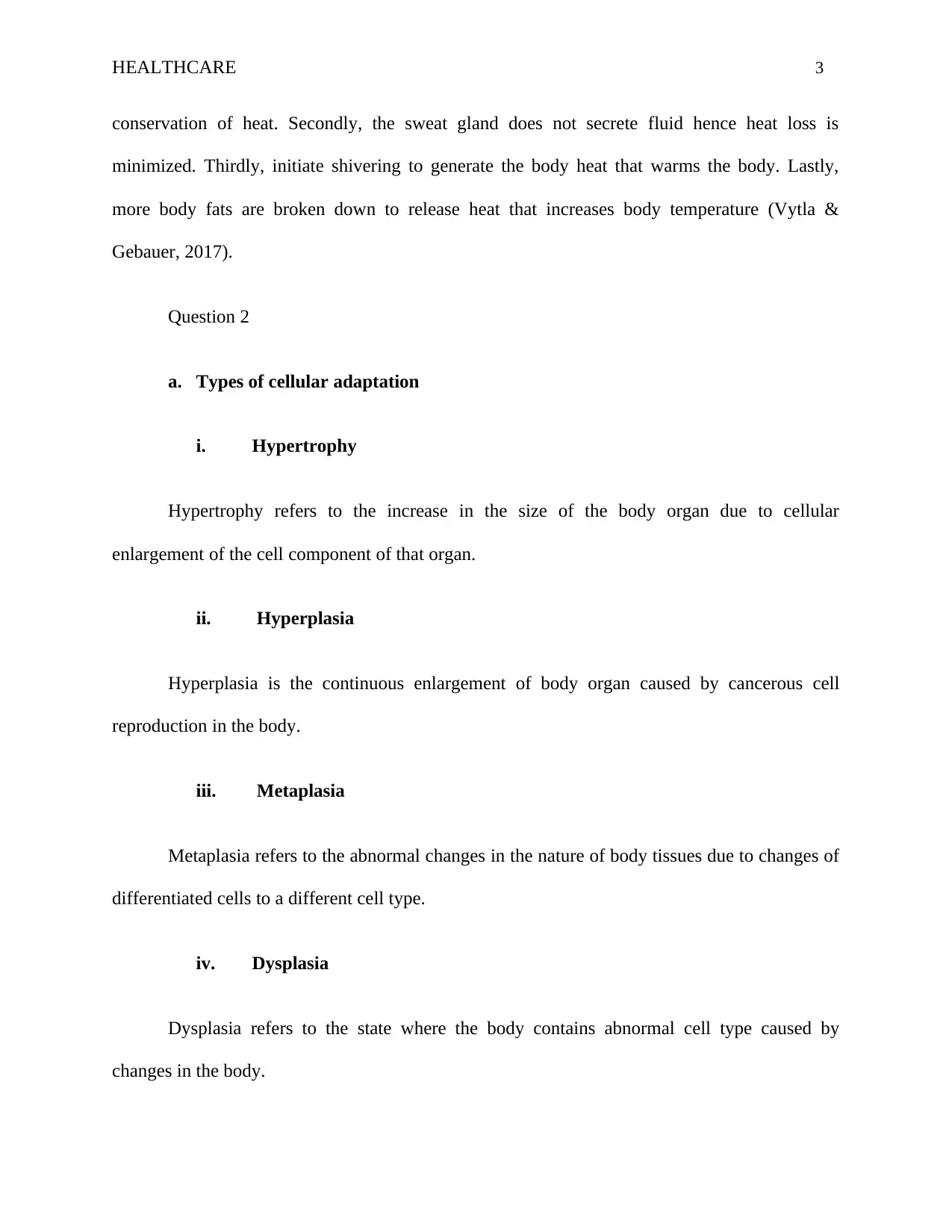
HEALTHCARE 3
conservation of heat. Secondly, the sweat gland does not secrete fluid hence heat loss is
minimized. Thirdly, initiate shivering to generate the body heat that warms the body. Lastly,
more body fats are broken down to release heat that increases body temperature (Vytla &
Gebauer, 2017).
Question 2
a. Types of cellular adaptation
i. Hypertrophy
Hypertrophy refers to the increase in the size of the body organ due to cellular
enlargement of the cell component of that organ.
ii. Hyperplasia
Hyperplasia is the continuous enlargement of body organ caused by cancerous cell
reproduction in the body.
iii. Metaplasia
Metaplasia refers to the abnormal changes in the nature of body tissues due to changes of
differentiated cells to a different cell type.
iv. Dysplasia
Dysplasia refers to the state where the body contains abnormal cell type caused by
changes in the body.
conservation of heat. Secondly, the sweat gland does not secrete fluid hence heat loss is
minimized. Thirdly, initiate shivering to generate the body heat that warms the body. Lastly,
more body fats are broken down to release heat that increases body temperature (Vytla &
Gebauer, 2017).
Question 2
a. Types of cellular adaptation
i. Hypertrophy
Hypertrophy refers to the increase in the size of the body organ due to cellular
enlargement of the cell component of that organ.
ii. Hyperplasia
Hyperplasia is the continuous enlargement of body organ caused by cancerous cell
reproduction in the body.
iii. Metaplasia
Metaplasia refers to the abnormal changes in the nature of body tissues due to changes of
differentiated cells to a different cell type.
iv. Dysplasia
Dysplasia refers to the state where the body contains abnormal cell type caused by
changes in the body.
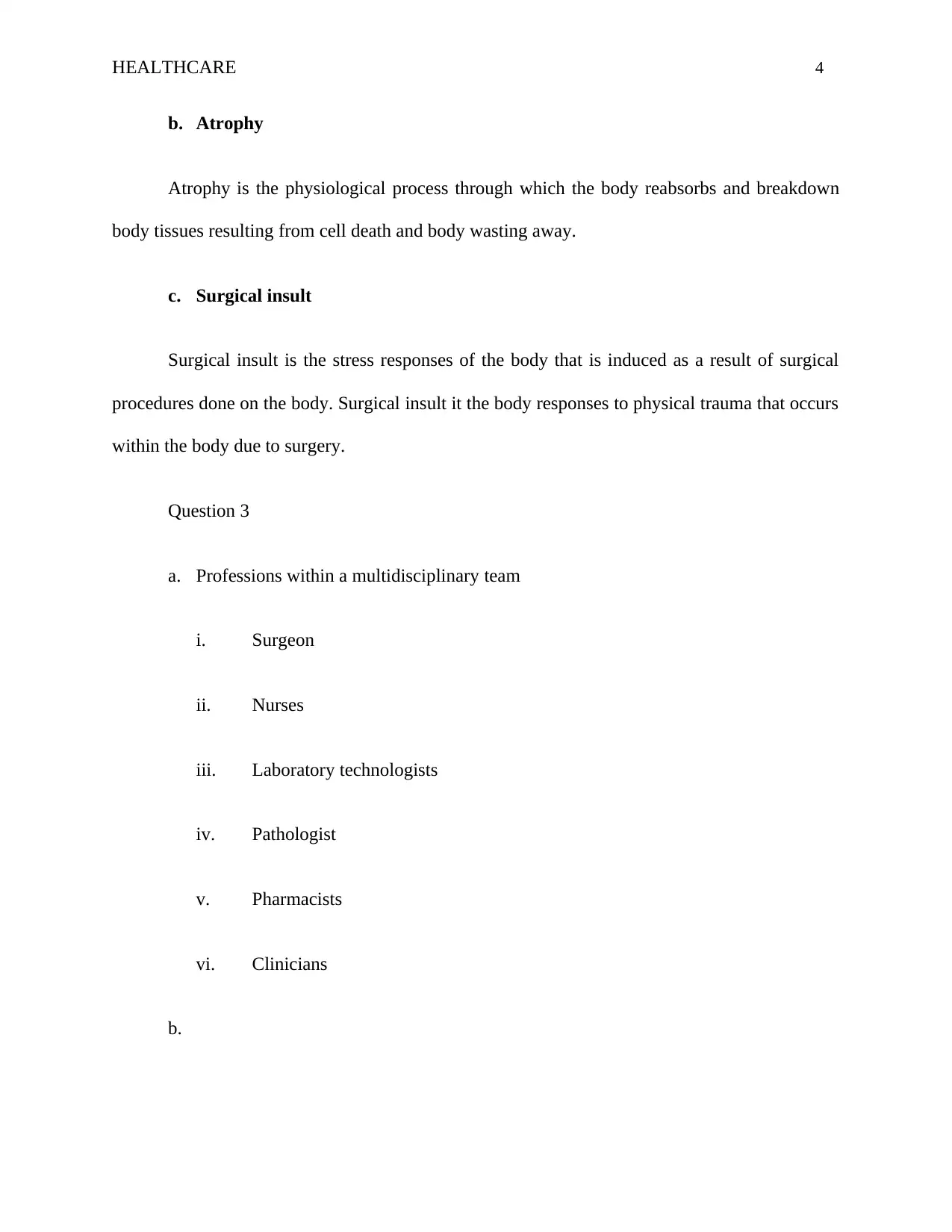
HEALTHCARE 4
b. Atrophy
Atrophy is the physiological process through which the body reabsorbs and breakdown
body tissues resulting from cell death and body wasting away.
c. Surgical insult
Surgical insult is the stress responses of the body that is induced as a result of surgical
procedures done on the body. Surgical insult it the body responses to physical trauma that occurs
within the body due to surgery.
Question 3
a. Professions within a multidisciplinary team
i. Surgeon
ii. Nurses
iii. Laboratory technologists
iv. Pathologist
v. Pharmacists
vi. Clinicians
b.
b. Atrophy
Atrophy is the physiological process through which the body reabsorbs and breakdown
body tissues resulting from cell death and body wasting away.
c. Surgical insult
Surgical insult is the stress responses of the body that is induced as a result of surgical
procedures done on the body. Surgical insult it the body responses to physical trauma that occurs
within the body due to surgery.
Question 3
a. Professions within a multidisciplinary team
i. Surgeon
ii. Nurses
iii. Laboratory technologists
iv. Pathologist
v. Pharmacists
vi. Clinicians
b.
Secure Best Marks with AI Grader
Need help grading? Try our AI Grader for instant feedback on your assignments.
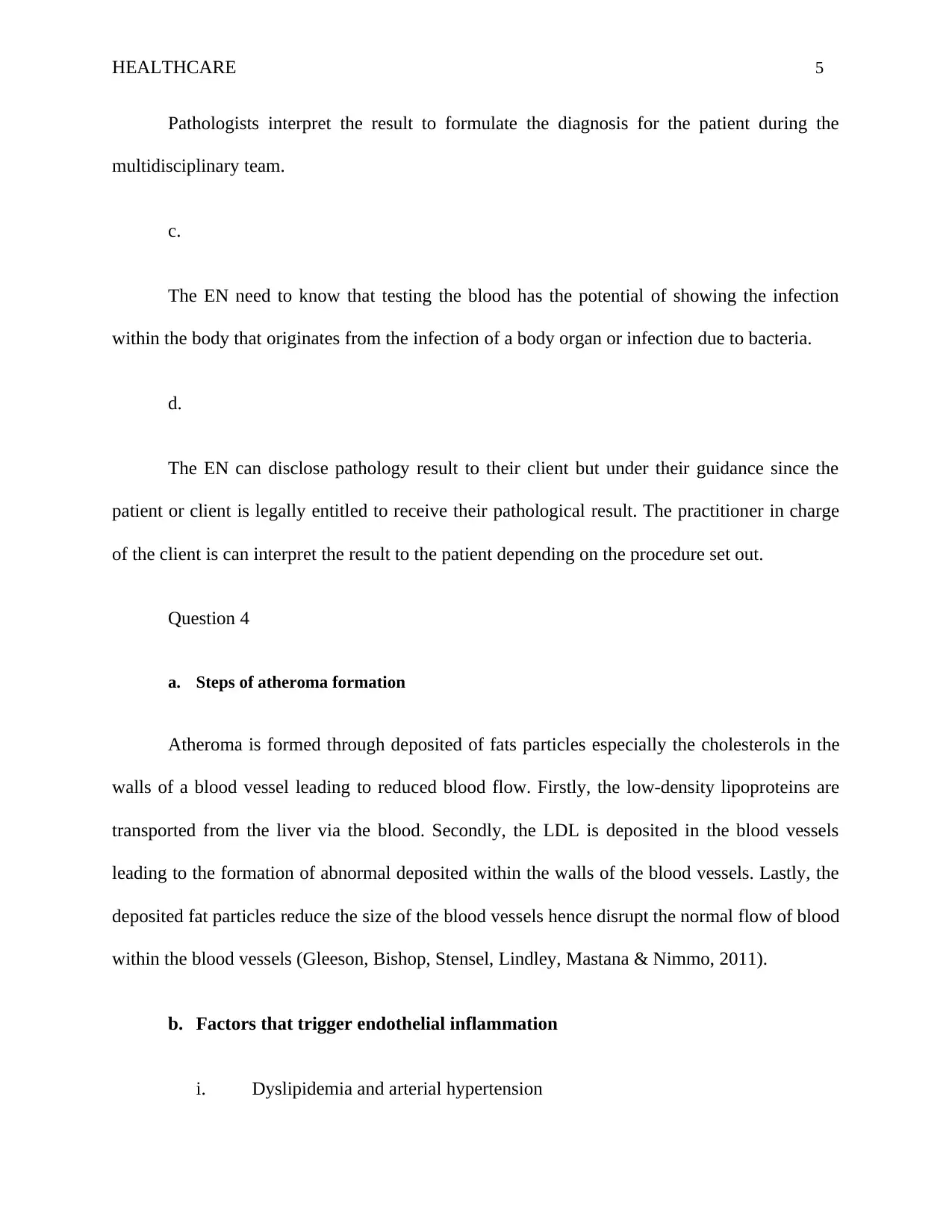
HEALTHCARE 5
Pathologists interpret the result to formulate the diagnosis for the patient during the
multidisciplinary team.
c.
The EN need to know that testing the blood has the potential of showing the infection
within the body that originates from the infection of a body organ or infection due to bacteria.
d.
The EN can disclose pathology result to their client but under their guidance since the
patient or client is legally entitled to receive their pathological result. The practitioner in charge
of the client is can interpret the result to the patient depending on the procedure set out.
Question 4
a. Steps of atheroma formation
Atheroma is formed through deposited of fats particles especially the cholesterols in the
walls of a blood vessel leading to reduced blood flow. Firstly, the low-density lipoproteins are
transported from the liver via the blood. Secondly, the LDL is deposited in the blood vessels
leading to the formation of abnormal deposited within the walls of the blood vessels. Lastly, the
deposited fat particles reduce the size of the blood vessels hence disrupt the normal flow of blood
within the blood vessels (Gleeson, Bishop, Stensel, Lindley, Mastana & Nimmo, 2011).
b. Factors that trigger endothelial inflammation
i. Dyslipidemia and arterial hypertension
Pathologists interpret the result to formulate the diagnosis for the patient during the
multidisciplinary team.
c.
The EN need to know that testing the blood has the potential of showing the infection
within the body that originates from the infection of a body organ or infection due to bacteria.
d.
The EN can disclose pathology result to their client but under their guidance since the
patient or client is legally entitled to receive their pathological result. The practitioner in charge
of the client is can interpret the result to the patient depending on the procedure set out.
Question 4
a. Steps of atheroma formation
Atheroma is formed through deposited of fats particles especially the cholesterols in the
walls of a blood vessel leading to reduced blood flow. Firstly, the low-density lipoproteins are
transported from the liver via the blood. Secondly, the LDL is deposited in the blood vessels
leading to the formation of abnormal deposited within the walls of the blood vessels. Lastly, the
deposited fat particles reduce the size of the blood vessels hence disrupt the normal flow of blood
within the blood vessels (Gleeson, Bishop, Stensel, Lindley, Mastana & Nimmo, 2011).
b. Factors that trigger endothelial inflammation
i. Dyslipidemia and arterial hypertension
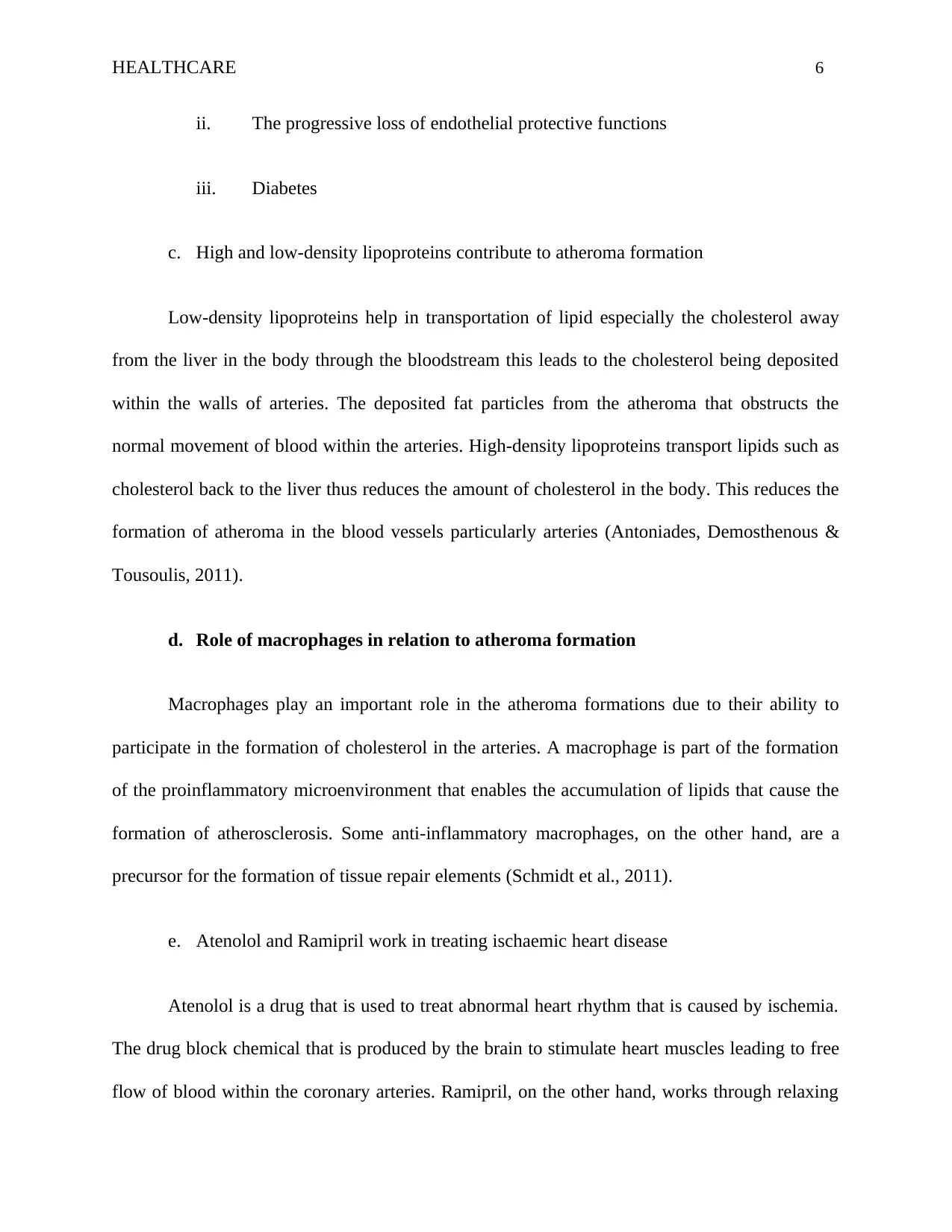
HEALTHCARE 6
ii. The progressive loss of endothelial protective functions
iii. Diabetes
c. High and low-density lipoproteins contribute to atheroma formation
Low-density lipoproteins help in transportation of lipid especially the cholesterol away
from the liver in the body through the bloodstream this leads to the cholesterol being deposited
within the walls of arteries. The deposited fat particles from the atheroma that obstructs the
normal movement of blood within the arteries. High-density lipoproteins transport lipids such as
cholesterol back to the liver thus reduces the amount of cholesterol in the body. This reduces the
formation of atheroma in the blood vessels particularly arteries (Antoniades, Demosthenous &
Tousoulis, 2011).
d. Role of macrophages in relation to atheroma formation
Macrophages play an important role in the atheroma formations due to their ability to
participate in the formation of cholesterol in the arteries. A macrophage is part of the formation
of the proinflammatory microenvironment that enables the accumulation of lipids that cause the
formation of atherosclerosis. Some anti-inflammatory macrophages, on the other hand, are a
precursor for the formation of tissue repair elements (Schmidt et al., 2011).
e. Atenolol and Ramipril work in treating ischaemic heart disease
Atenolol is a drug that is used to treat abnormal heart rhythm that is caused by ischemia.
The drug block chemical that is produced by the brain to stimulate heart muscles leading to free
flow of blood within the coronary arteries. Ramipril, on the other hand, works through relaxing
ii. The progressive loss of endothelial protective functions
iii. Diabetes
c. High and low-density lipoproteins contribute to atheroma formation
Low-density lipoproteins help in transportation of lipid especially the cholesterol away
from the liver in the body through the bloodstream this leads to the cholesterol being deposited
within the walls of arteries. The deposited fat particles from the atheroma that obstructs the
normal movement of blood within the arteries. High-density lipoproteins transport lipids such as
cholesterol back to the liver thus reduces the amount of cholesterol in the body. This reduces the
formation of atheroma in the blood vessels particularly arteries (Antoniades, Demosthenous &
Tousoulis, 2011).
d. Role of macrophages in relation to atheroma formation
Macrophages play an important role in the atheroma formations due to their ability to
participate in the formation of cholesterol in the arteries. A macrophage is part of the formation
of the proinflammatory microenvironment that enables the accumulation of lipids that cause the
formation of atherosclerosis. Some anti-inflammatory macrophages, on the other hand, are a
precursor for the formation of tissue repair elements (Schmidt et al., 2011).
e. Atenolol and Ramipril work in treating ischaemic heart disease
Atenolol is a drug that is used to treat abnormal heart rhythm that is caused by ischemia.
The drug block chemical that is produced by the brain to stimulate heart muscles leading to free
flow of blood within the coronary arteries. Ramipril, on the other hand, works through relaxing
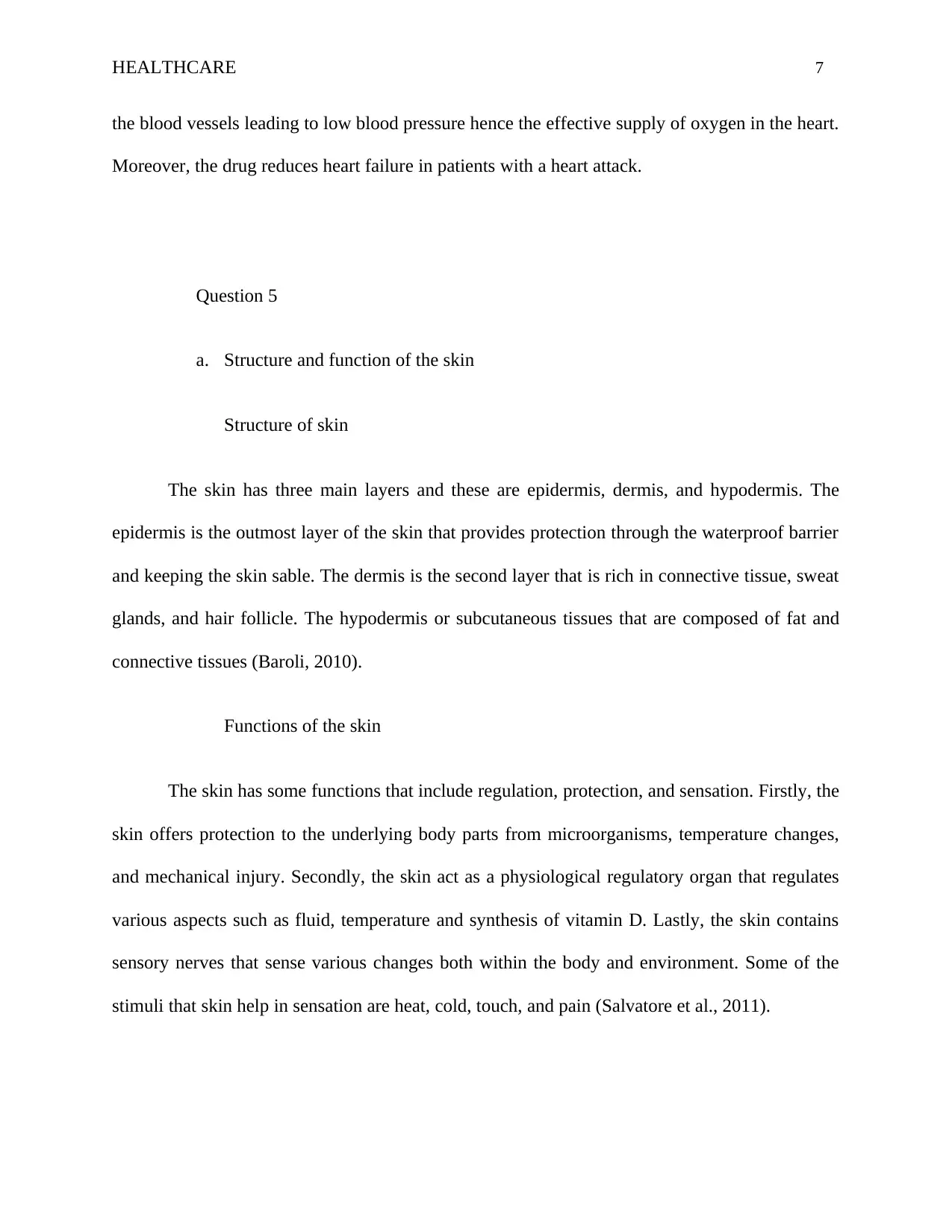
HEALTHCARE 7
the blood vessels leading to low blood pressure hence the effective supply of oxygen in the heart.
Moreover, the drug reduces heart failure in patients with a heart attack.
Question 5
a. Structure and function of the skin
Structure of skin
The skin has three main layers and these are epidermis, dermis, and hypodermis. The
epidermis is the outmost layer of the skin that provides protection through the waterproof barrier
and keeping the skin sable. The dermis is the second layer that is rich in connective tissue, sweat
glands, and hair follicle. The hypodermis or subcutaneous tissues that are composed of fat and
connective tissues (Baroli, 2010).
Functions of the skin
The skin has some functions that include regulation, protection, and sensation. Firstly, the
skin offers protection to the underlying body parts from microorganisms, temperature changes,
and mechanical injury. Secondly, the skin act as a physiological regulatory organ that regulates
various aspects such as fluid, temperature and synthesis of vitamin D. Lastly, the skin contains
sensory nerves that sense various changes both within the body and environment. Some of the
stimuli that skin help in sensation are heat, cold, touch, and pain (Salvatore et al., 2011).
the blood vessels leading to low blood pressure hence the effective supply of oxygen in the heart.
Moreover, the drug reduces heart failure in patients with a heart attack.
Question 5
a. Structure and function of the skin
Structure of skin
The skin has three main layers and these are epidermis, dermis, and hypodermis. The
epidermis is the outmost layer of the skin that provides protection through the waterproof barrier
and keeping the skin sable. The dermis is the second layer that is rich in connective tissue, sweat
glands, and hair follicle. The hypodermis or subcutaneous tissues that are composed of fat and
connective tissues (Baroli, 2010).
Functions of the skin
The skin has some functions that include regulation, protection, and sensation. Firstly, the
skin offers protection to the underlying body parts from microorganisms, temperature changes,
and mechanical injury. Secondly, the skin act as a physiological regulatory organ that regulates
various aspects such as fluid, temperature and synthesis of vitamin D. Lastly, the skin contains
sensory nerves that sense various changes both within the body and environment. Some of the
stimuli that skin help in sensation are heat, cold, touch, and pain (Salvatore et al., 2011).
Paraphrase This Document
Need a fresh take? Get an instant paraphrase of this document with our AI Paraphraser
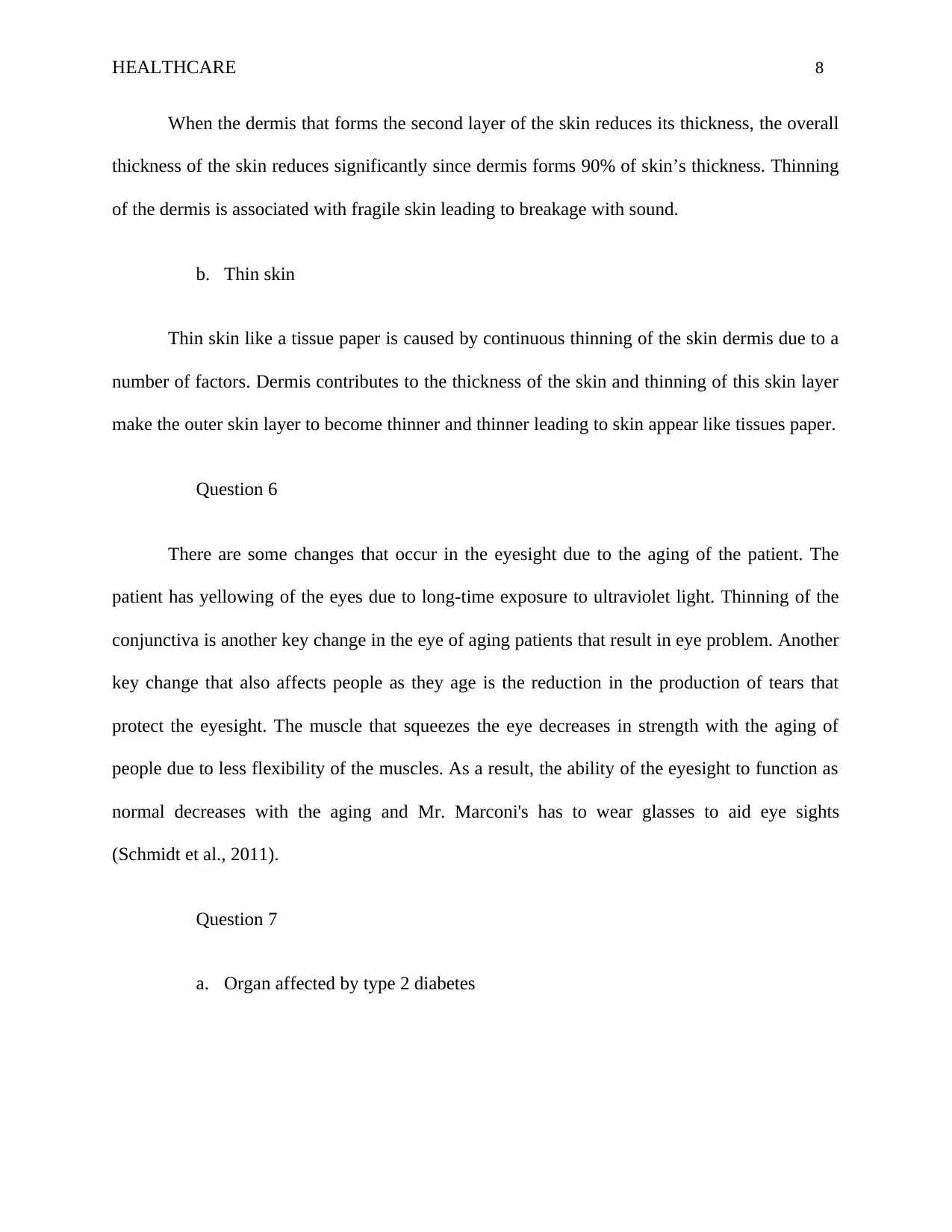
HEALTHCARE 8
When the dermis that forms the second layer of the skin reduces its thickness, the overall
thickness of the skin reduces significantly since dermis forms 90% of skin’s thickness. Thinning
of the dermis is associated with fragile skin leading to breakage with sound.
b. Thin skin
Thin skin like a tissue paper is caused by continuous thinning of the skin dermis due to a
number of factors. Dermis contributes to the thickness of the skin and thinning of this skin layer
make the outer skin layer to become thinner and thinner leading to skin appear like tissues paper.
Question 6
There are some changes that occur in the eyesight due to the aging of the patient. The
patient has yellowing of the eyes due to long-time exposure to ultraviolet light. Thinning of the
conjunctiva is another key change in the eye of aging patients that result in eye problem. Another
key change that also affects people as they age is the reduction in the production of tears that
protect the eyesight. The muscle that squeezes the eye decreases in strength with the aging of
people due to less flexibility of the muscles. As a result, the ability of the eyesight to function as
normal decreases with the aging and Mr. Marconi's has to wear glasses to aid eye sights
(Schmidt et al., 2011).
Question 7
a. Organ affected by type 2 diabetes
When the dermis that forms the second layer of the skin reduces its thickness, the overall
thickness of the skin reduces significantly since dermis forms 90% of skin’s thickness. Thinning
of the dermis is associated with fragile skin leading to breakage with sound.
b. Thin skin
Thin skin like a tissue paper is caused by continuous thinning of the skin dermis due to a
number of factors. Dermis contributes to the thickness of the skin and thinning of this skin layer
make the outer skin layer to become thinner and thinner leading to skin appear like tissues paper.
Question 6
There are some changes that occur in the eyesight due to the aging of the patient. The
patient has yellowing of the eyes due to long-time exposure to ultraviolet light. Thinning of the
conjunctiva is another key change in the eye of aging patients that result in eye problem. Another
key change that also affects people as they age is the reduction in the production of tears that
protect the eyesight. The muscle that squeezes the eye decreases in strength with the aging of
people due to less flexibility of the muscles. As a result, the ability of the eyesight to function as
normal decreases with the aging and Mr. Marconi's has to wear glasses to aid eye sights
(Schmidt et al., 2011).
Question 7
a. Organ affected by type 2 diabetes
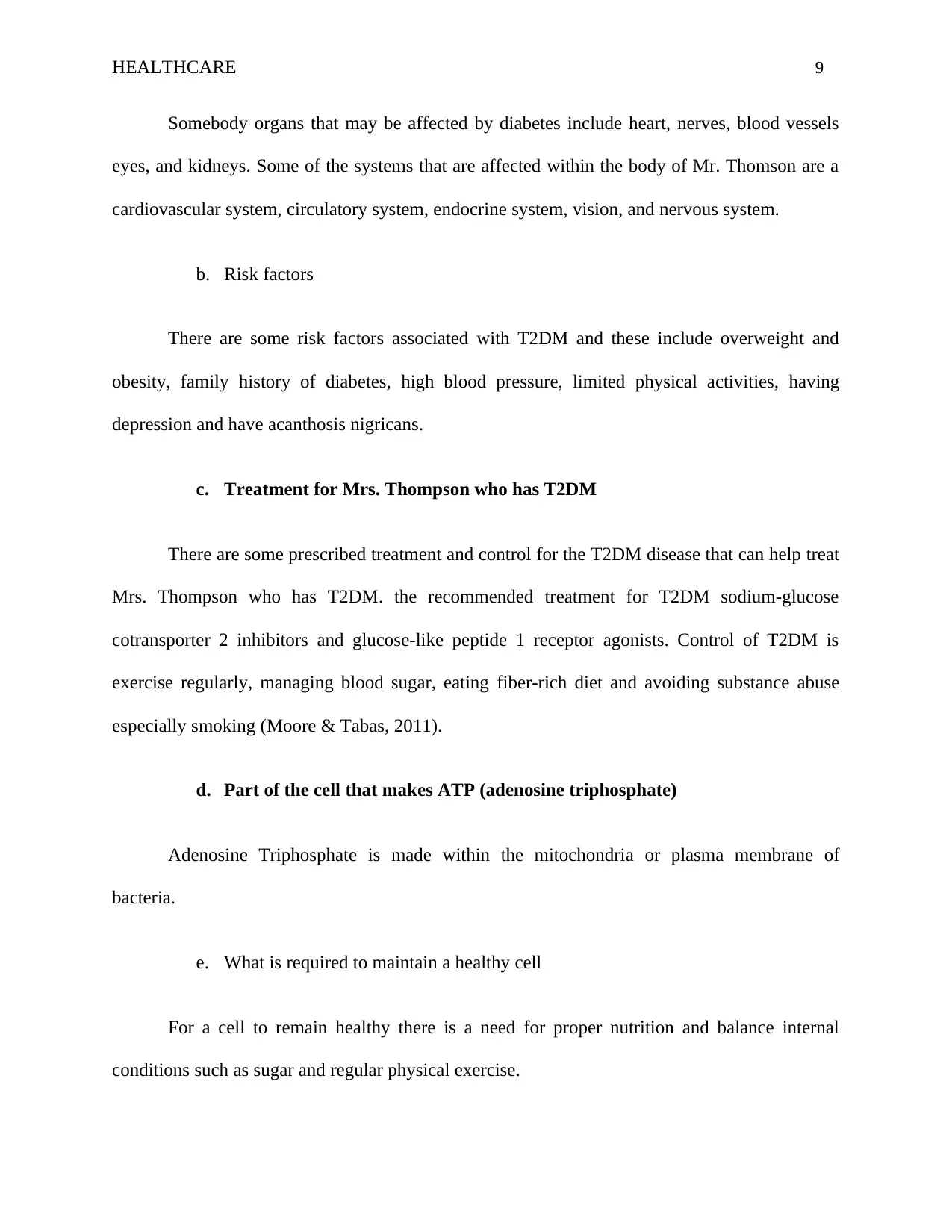
HEALTHCARE 9
Somebody organs that may be affected by diabetes include heart, nerves, blood vessels
eyes, and kidneys. Some of the systems that are affected within the body of Mr. Thomson are a
cardiovascular system, circulatory system, endocrine system, vision, and nervous system.
b. Risk factors
There are some risk factors associated with T2DM and these include overweight and
obesity, family history of diabetes, high blood pressure, limited physical activities, having
depression and have acanthosis nigricans.
c. Treatment for Mrs. Thompson who has T2DM
There are some prescribed treatment and control for the T2DM disease that can help treat
Mrs. Thompson who has T2DM. the recommended treatment for T2DM sodium-glucose
cotransporter 2 inhibitors and glucose-like peptide 1 receptor agonists. Control of T2DM is
exercise regularly, managing blood sugar, eating fiber-rich diet and avoiding substance abuse
especially smoking (Moore & Tabas, 2011).
d. Part of the cell that makes ATP (adenosine triphosphate)
Adenosine Triphosphate is made within the mitochondria or plasma membrane of
bacteria.
e. What is required to maintain a healthy cell
For a cell to remain healthy there is a need for proper nutrition and balance internal
conditions such as sugar and regular physical exercise.
Somebody organs that may be affected by diabetes include heart, nerves, blood vessels
eyes, and kidneys. Some of the systems that are affected within the body of Mr. Thomson are a
cardiovascular system, circulatory system, endocrine system, vision, and nervous system.
b. Risk factors
There are some risk factors associated with T2DM and these include overweight and
obesity, family history of diabetes, high blood pressure, limited physical activities, having
depression and have acanthosis nigricans.
c. Treatment for Mrs. Thompson who has T2DM
There are some prescribed treatment and control for the T2DM disease that can help treat
Mrs. Thompson who has T2DM. the recommended treatment for T2DM sodium-glucose
cotransporter 2 inhibitors and glucose-like peptide 1 receptor agonists. Control of T2DM is
exercise regularly, managing blood sugar, eating fiber-rich diet and avoiding substance abuse
especially smoking (Moore & Tabas, 2011).
d. Part of the cell that makes ATP (adenosine triphosphate)
Adenosine Triphosphate is made within the mitochondria or plasma membrane of
bacteria.
e. What is required to maintain a healthy cell
For a cell to remain healthy there is a need for proper nutrition and balance internal
conditions such as sugar and regular physical exercise.
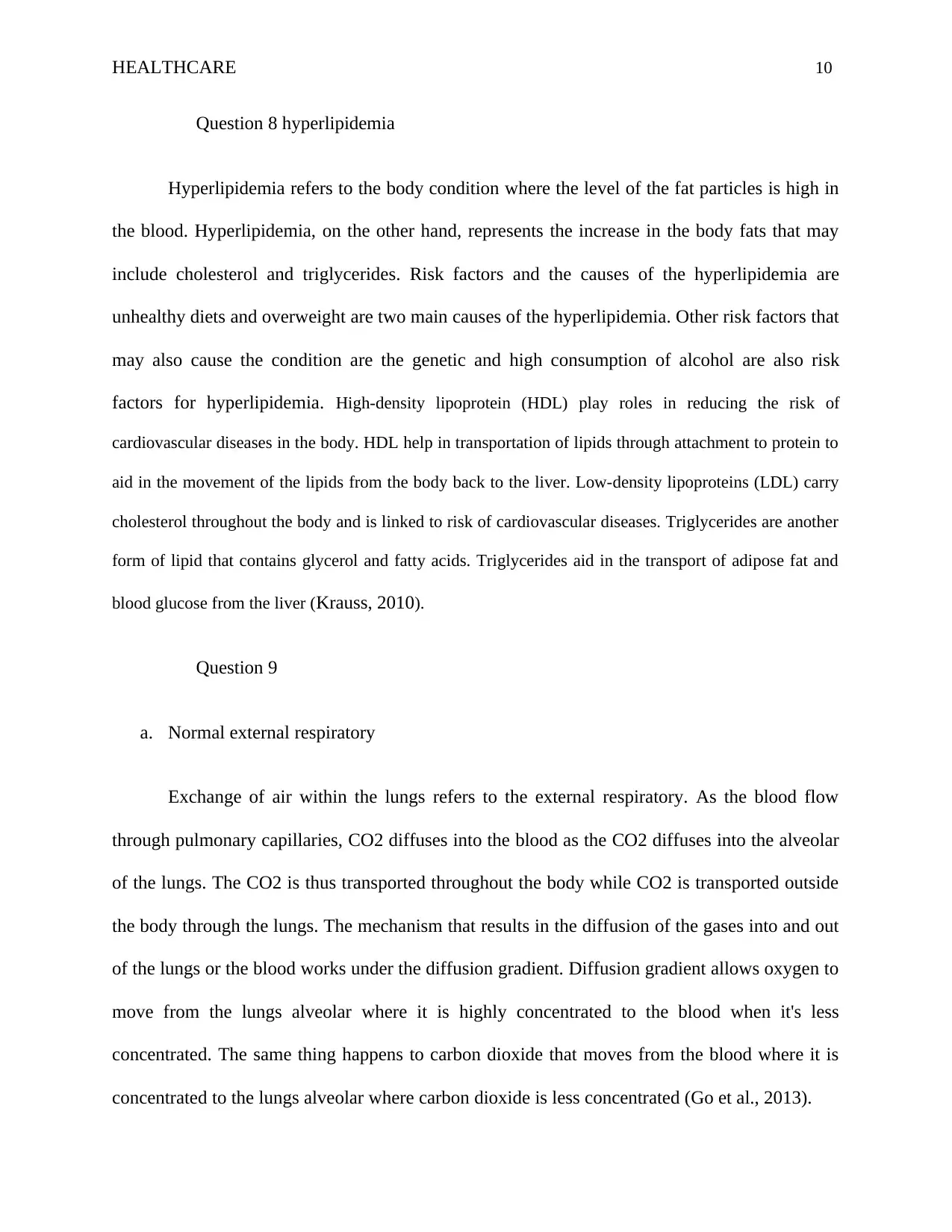
HEALTHCARE 10
Question 8 hyperlipidemia
Hyperlipidemia refers to the body condition where the level of the fat particles is high in
the blood. Hyperlipidemia, on the other hand, represents the increase in the body fats that may
include cholesterol and triglycerides. Risk factors and the causes of the hyperlipidemia are
unhealthy diets and overweight are two main causes of the hyperlipidemia. Other risk factors that
may also cause the condition are the genetic and high consumption of alcohol are also risk
factors for hyperlipidemia. High-density lipoprotein (HDL) play roles in reducing the risk of
cardiovascular diseases in the body. HDL help in transportation of lipids through attachment to protein to
aid in the movement of the lipids from the body back to the liver. Low-density lipoproteins (LDL) carry
cholesterol throughout the body and is linked to risk of cardiovascular diseases. Triglycerides are another
form of lipid that contains glycerol and fatty acids. Triglycerides aid in the transport of adipose fat and
blood glucose from the liver (Krauss, 2010).
Question 9
a. Normal external respiratory
Exchange of air within the lungs refers to the external respiratory. As the blood flow
through pulmonary capillaries, CO2 diffuses into the blood as the CO2 diffuses into the alveolar
of the lungs. The CO2 is thus transported throughout the body while CO2 is transported outside
the body through the lungs. The mechanism that results in the diffusion of the gases into and out
of the lungs or the blood works under the diffusion gradient. Diffusion gradient allows oxygen to
move from the lungs alveolar where it is highly concentrated to the blood when it's less
concentrated. The same thing happens to carbon dioxide that moves from the blood where it is
concentrated to the lungs alveolar where carbon dioxide is less concentrated (Go et al., 2013).
Question 8 hyperlipidemia
Hyperlipidemia refers to the body condition where the level of the fat particles is high in
the blood. Hyperlipidemia, on the other hand, represents the increase in the body fats that may
include cholesterol and triglycerides. Risk factors and the causes of the hyperlipidemia are
unhealthy diets and overweight are two main causes of the hyperlipidemia. Other risk factors that
may also cause the condition are the genetic and high consumption of alcohol are also risk
factors for hyperlipidemia. High-density lipoprotein (HDL) play roles in reducing the risk of
cardiovascular diseases in the body. HDL help in transportation of lipids through attachment to protein to
aid in the movement of the lipids from the body back to the liver. Low-density lipoproteins (LDL) carry
cholesterol throughout the body and is linked to risk of cardiovascular diseases. Triglycerides are another
form of lipid that contains glycerol and fatty acids. Triglycerides aid in the transport of adipose fat and
blood glucose from the liver (Krauss, 2010).
Question 9
a. Normal external respiratory
Exchange of air within the lungs refers to the external respiratory. As the blood flow
through pulmonary capillaries, CO2 diffuses into the blood as the CO2 diffuses into the alveolar
of the lungs. The CO2 is thus transported throughout the body while CO2 is transported outside
the body through the lungs. The mechanism that results in the diffusion of the gases into and out
of the lungs or the blood works under the diffusion gradient. Diffusion gradient allows oxygen to
move from the lungs alveolar where it is highly concentrated to the blood when it's less
concentrated. The same thing happens to carbon dioxide that moves from the blood where it is
concentrated to the lungs alveolar where carbon dioxide is less concentrated (Go et al., 2013).
Secure Best Marks with AI Grader
Need help grading? Try our AI Grader for instant feedback on your assignments.
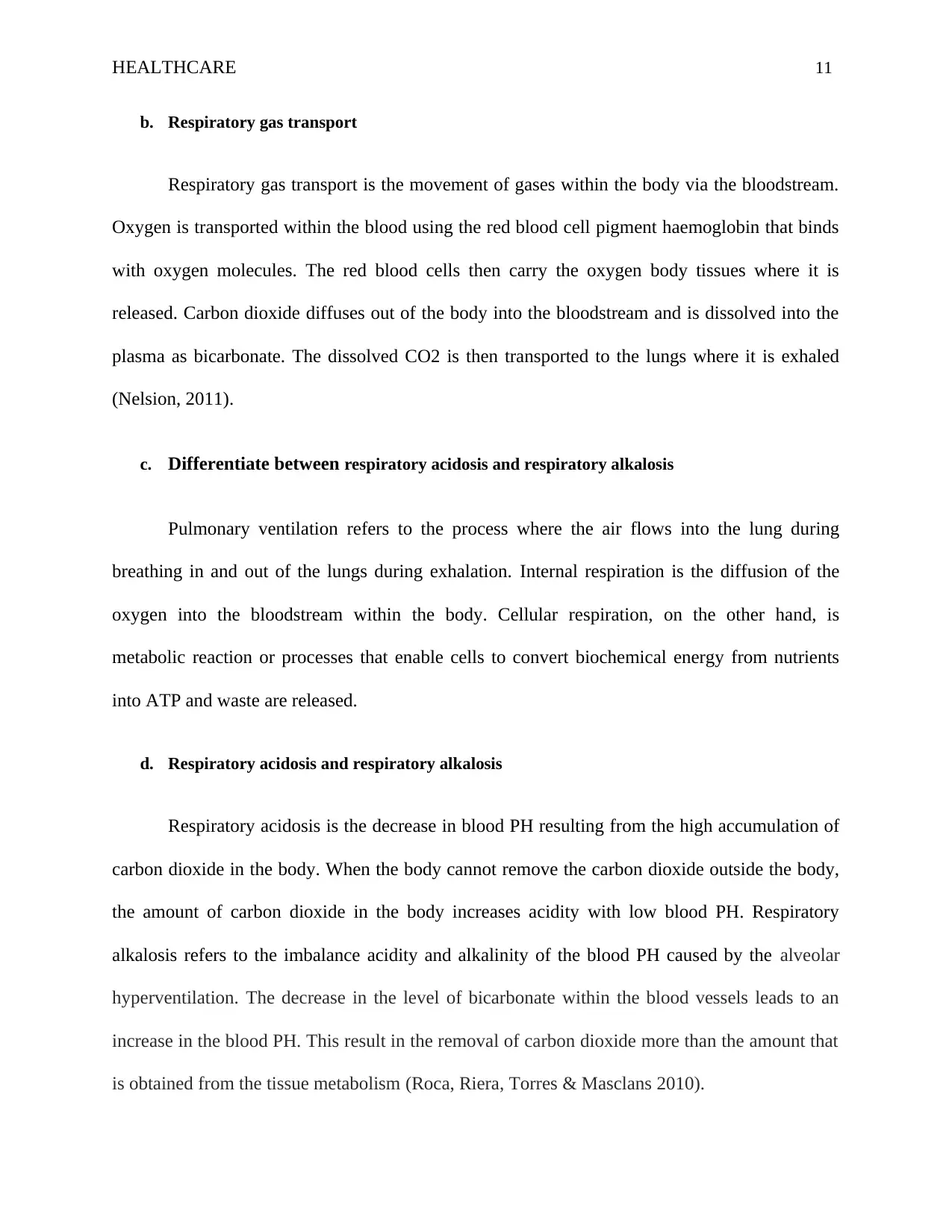
HEALTHCARE 11
b. Respiratory gas transport
Respiratory gas transport is the movement of gases within the body via the bloodstream.
Oxygen is transported within the blood using the red blood cell pigment haemoglobin that binds
with oxygen molecules. The red blood cells then carry the oxygen body tissues where it is
released. Carbon dioxide diffuses out of the body into the bloodstream and is dissolved into the
plasma as bicarbonate. The dissolved CO2 is then transported to the lungs where it is exhaled
(Nelsion, 2011).
c. Differentiate between respiratory acidosis and respiratory alkalosis
Pulmonary ventilation refers to the process where the air flows into the lung during
breathing in and out of the lungs during exhalation. Internal respiration is the diffusion of the
oxygen into the bloodstream within the body. Cellular respiration, on the other hand, is
metabolic reaction or processes that enable cells to convert biochemical energy from nutrients
into ATP and waste are released.
d. Respiratory acidosis and respiratory alkalosis
Respiratory acidosis is the decrease in blood PH resulting from the high accumulation of
carbon dioxide in the body. When the body cannot remove the carbon dioxide outside the body,
the amount of carbon dioxide in the body increases acidity with low blood PH. Respiratory
alkalosis refers to the imbalance acidity and alkalinity of the blood PH caused by the alveolar
hyperventilation. The decrease in the level of bicarbonate within the blood vessels leads to an
increase in the blood PH. This result in the removal of carbon dioxide more than the amount that
is obtained from the tissue metabolism (Roca, Riera, Torres & Masclans 2010).
b. Respiratory gas transport
Respiratory gas transport is the movement of gases within the body via the bloodstream.
Oxygen is transported within the blood using the red blood cell pigment haemoglobin that binds
with oxygen molecules. The red blood cells then carry the oxygen body tissues where it is
released. Carbon dioxide diffuses out of the body into the bloodstream and is dissolved into the
plasma as bicarbonate. The dissolved CO2 is then transported to the lungs where it is exhaled
(Nelsion, 2011).
c. Differentiate between respiratory acidosis and respiratory alkalosis
Pulmonary ventilation refers to the process where the air flows into the lung during
breathing in and out of the lungs during exhalation. Internal respiration is the diffusion of the
oxygen into the bloodstream within the body. Cellular respiration, on the other hand, is
metabolic reaction or processes that enable cells to convert biochemical energy from nutrients
into ATP and waste are released.
d. Respiratory acidosis and respiratory alkalosis
Respiratory acidosis is the decrease in blood PH resulting from the high accumulation of
carbon dioxide in the body. When the body cannot remove the carbon dioxide outside the body,
the amount of carbon dioxide in the body increases acidity with low blood PH. Respiratory
alkalosis refers to the imbalance acidity and alkalinity of the blood PH caused by the alveolar
hyperventilation. The decrease in the level of bicarbonate within the blood vessels leads to an
increase in the blood PH. This result in the removal of carbon dioxide more than the amount that
is obtained from the tissue metabolism (Roca, Riera, Torres & Masclans 2010).
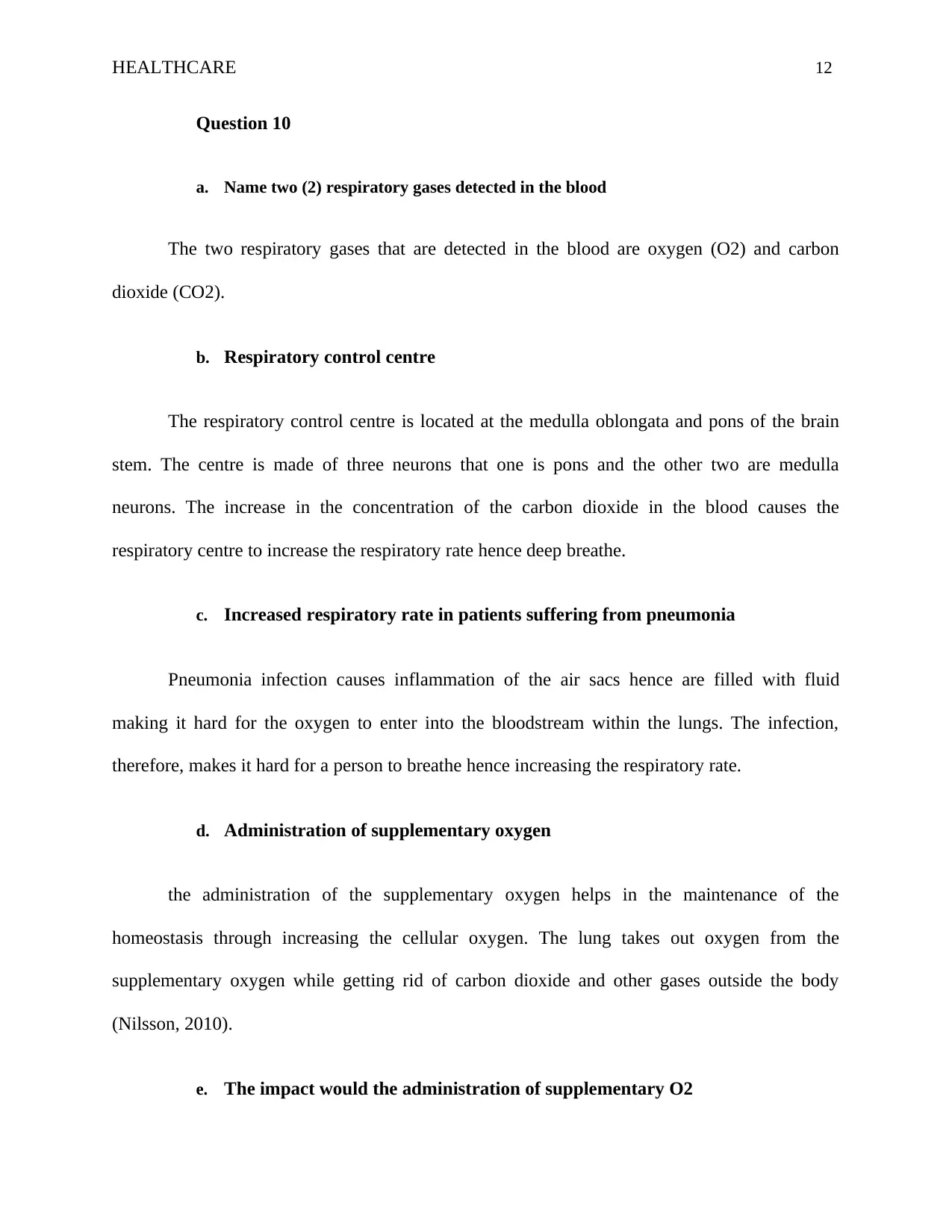
HEALTHCARE 12
Question 10
a. Name two (2) respiratory gases detected in the blood
The two respiratory gases that are detected in the blood are oxygen (O2) and carbon
dioxide (CO2).
b. Respiratory control centre
The respiratory control centre is located at the medulla oblongata and pons of the brain
stem. The centre is made of three neurons that one is pons and the other two are medulla
neurons. The increase in the concentration of the carbon dioxide in the blood causes the
respiratory centre to increase the respiratory rate hence deep breathe.
c. Increased respiratory rate in patients suffering from pneumonia
Pneumonia infection causes inflammation of the air sacs hence are filled with fluid
making it hard for the oxygen to enter into the bloodstream within the lungs. The infection,
therefore, makes it hard for a person to breathe hence increasing the respiratory rate.
d. Administration of supplementary oxygen
the administration of the supplementary oxygen helps in the maintenance of the
homeostasis through increasing the cellular oxygen. The lung takes out oxygen from the
supplementary oxygen while getting rid of carbon dioxide and other gases outside the body
(Nilsson, 2010).
e. The impact would the administration of supplementary O2
Question 10
a. Name two (2) respiratory gases detected in the blood
The two respiratory gases that are detected in the blood are oxygen (O2) and carbon
dioxide (CO2).
b. Respiratory control centre
The respiratory control centre is located at the medulla oblongata and pons of the brain
stem. The centre is made of three neurons that one is pons and the other two are medulla
neurons. The increase in the concentration of the carbon dioxide in the blood causes the
respiratory centre to increase the respiratory rate hence deep breathe.
c. Increased respiratory rate in patients suffering from pneumonia
Pneumonia infection causes inflammation of the air sacs hence are filled with fluid
making it hard for the oxygen to enter into the bloodstream within the lungs. The infection,
therefore, makes it hard for a person to breathe hence increasing the respiratory rate.
d. Administration of supplementary oxygen
the administration of the supplementary oxygen helps in the maintenance of the
homeostasis through increasing the cellular oxygen. The lung takes out oxygen from the
supplementary oxygen while getting rid of carbon dioxide and other gases outside the body
(Nilsson, 2010).
e. The impact would the administration of supplementary O2
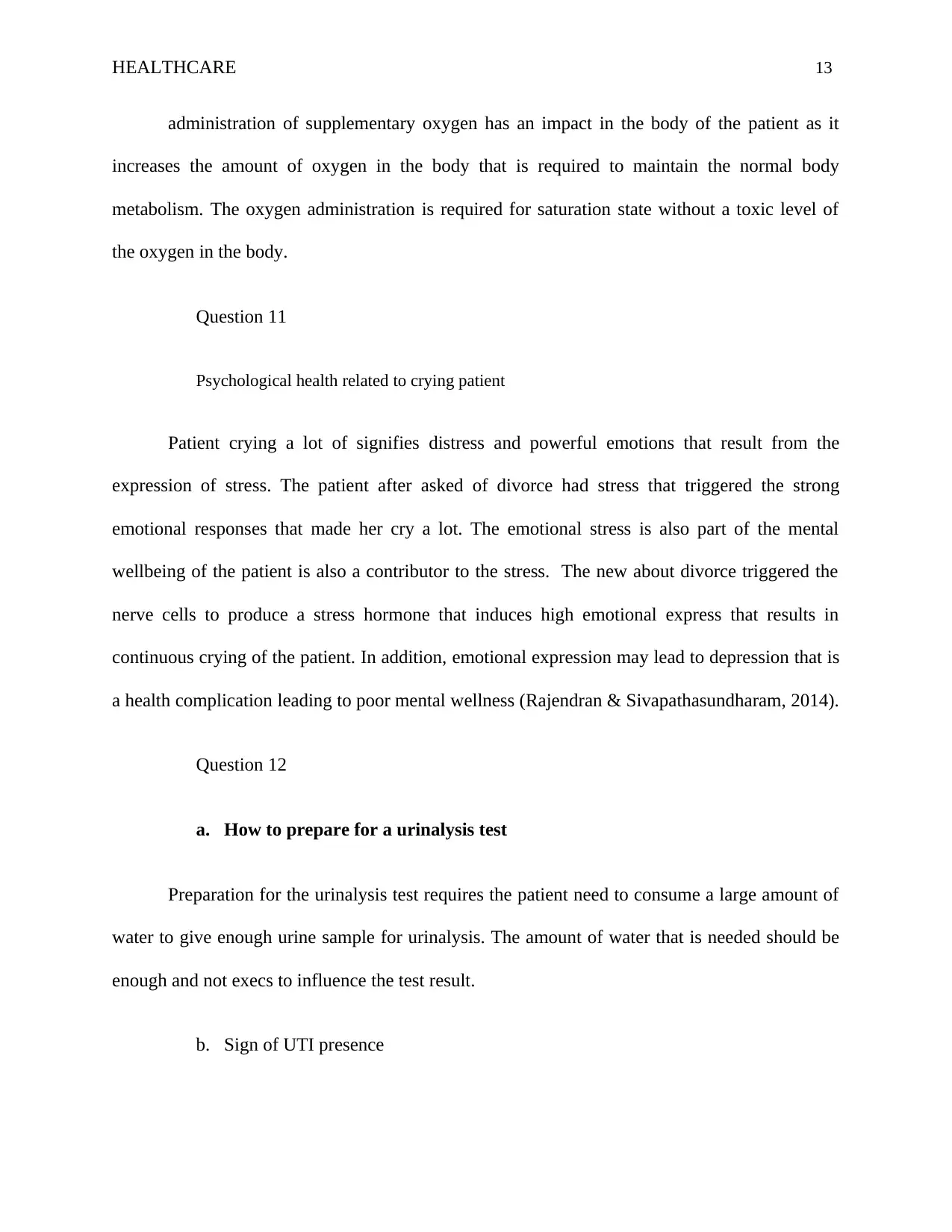
HEALTHCARE 13
administration of supplementary oxygen has an impact in the body of the patient as it
increases the amount of oxygen in the body that is required to maintain the normal body
metabolism. The oxygen administration is required for saturation state without a toxic level of
the oxygen in the body.
Question 11
Psychological health related to crying patient
Patient crying a lot of signifies distress and powerful emotions that result from the
expression of stress. The patient after asked of divorce had stress that triggered the strong
emotional responses that made her cry a lot. The emotional stress is also part of the mental
wellbeing of the patient is also a contributor to the stress. The new about divorce triggered the
nerve cells to produce a stress hormone that induces high emotional express that results in
continuous crying of the patient. In addition, emotional expression may lead to depression that is
a health complication leading to poor mental wellness (Rajendran & Sivapathasundharam, 2014).
Question 12
a. How to prepare for a urinalysis test
Preparation for the urinalysis test requires the patient need to consume a large amount of
water to give enough urine sample for urinalysis. The amount of water that is needed should be
enough and not execs to influence the test result.
b. Sign of UTI presence
administration of supplementary oxygen has an impact in the body of the patient as it
increases the amount of oxygen in the body that is required to maintain the normal body
metabolism. The oxygen administration is required for saturation state without a toxic level of
the oxygen in the body.
Question 11
Psychological health related to crying patient
Patient crying a lot of signifies distress and powerful emotions that result from the
expression of stress. The patient after asked of divorce had stress that triggered the strong
emotional responses that made her cry a lot. The emotional stress is also part of the mental
wellbeing of the patient is also a contributor to the stress. The new about divorce triggered the
nerve cells to produce a stress hormone that induces high emotional express that results in
continuous crying of the patient. In addition, emotional expression may lead to depression that is
a health complication leading to poor mental wellness (Rajendran & Sivapathasundharam, 2014).
Question 12
a. How to prepare for a urinalysis test
Preparation for the urinalysis test requires the patient need to consume a large amount of
water to give enough urine sample for urinalysis. The amount of water that is needed should be
enough and not execs to influence the test result.
b. Sign of UTI presence
Paraphrase This Document
Need a fresh take? Get an instant paraphrase of this document with our AI Paraphraser
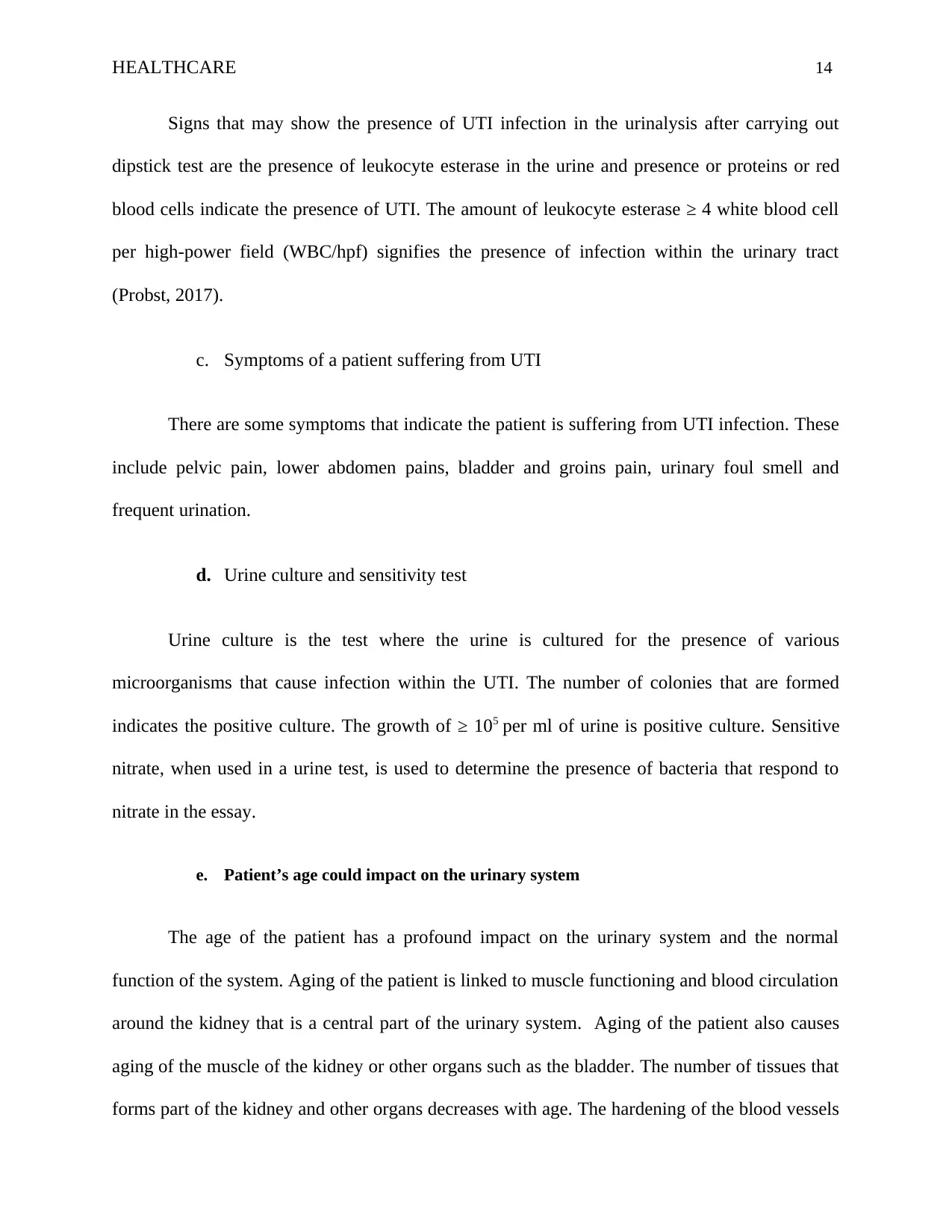
HEALTHCARE 14
Signs that may show the presence of UTI infection in the urinalysis after carrying out
dipstick test are the presence of leukocyte esterase in the urine and presence or proteins or red
blood cells indicate the presence of UTI. The amount of leukocyte esterase ≥ 4 white blood cell
per high-power field (WBC/hpf) signifies the presence of infection within the urinary tract
(Probst, 2017).
c. Symptoms of a patient suffering from UTI
There are some symptoms that indicate the patient is suffering from UTI infection. These
include pelvic pain, lower abdomen pains, bladder and groins pain, urinary foul smell and
frequent urination.
d. Urine culture and sensitivity test
Urine culture is the test where the urine is cultured for the presence of various
microorganisms that cause infection within the UTI. The number of colonies that are formed
indicates the positive culture. The growth of ≥ 105 per ml of urine is positive culture. Sensitive
nitrate, when used in a urine test, is used to determine the presence of bacteria that respond to
nitrate in the essay.
e. Patient’s age could impact on the urinary system
The age of the patient has a profound impact on the urinary system and the normal
function of the system. Aging of the patient is linked to muscle functioning and blood circulation
around the kidney that is a central part of the urinary system. Aging of the patient also causes
aging of the muscle of the kidney or other organs such as the bladder. The number of tissues that
forms part of the kidney and other organs decreases with age. The hardening of the blood vessels
Signs that may show the presence of UTI infection in the urinalysis after carrying out
dipstick test are the presence of leukocyte esterase in the urine and presence or proteins or red
blood cells indicate the presence of UTI. The amount of leukocyte esterase ≥ 4 white blood cell
per high-power field (WBC/hpf) signifies the presence of infection within the urinary tract
(Probst, 2017).
c. Symptoms of a patient suffering from UTI
There are some symptoms that indicate the patient is suffering from UTI infection. These
include pelvic pain, lower abdomen pains, bladder and groins pain, urinary foul smell and
frequent urination.
d. Urine culture and sensitivity test
Urine culture is the test where the urine is cultured for the presence of various
microorganisms that cause infection within the UTI. The number of colonies that are formed
indicates the positive culture. The growth of ≥ 105 per ml of urine is positive culture. Sensitive
nitrate, when used in a urine test, is used to determine the presence of bacteria that respond to
nitrate in the essay.
e. Patient’s age could impact on the urinary system
The age of the patient has a profound impact on the urinary system and the normal
function of the system. Aging of the patient is linked to muscle functioning and blood circulation
around the kidney that is a central part of the urinary system. Aging of the patient also causes
aging of the muscle of the kidney or other organs such as the bladder. The number of tissues that
forms part of the kidney and other organs decreases with age. The hardening of the blood vessels
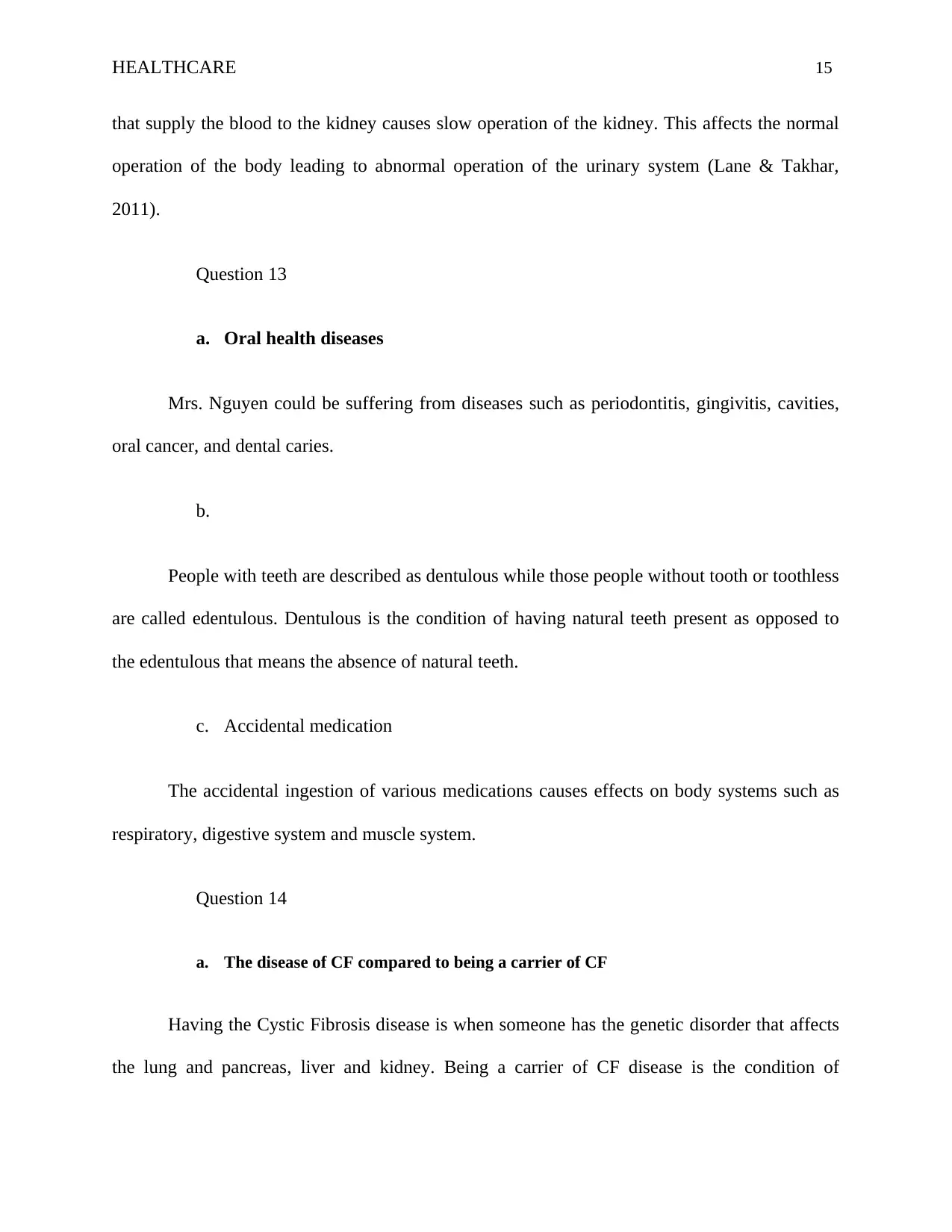
HEALTHCARE 15
that supply the blood to the kidney causes slow operation of the kidney. This affects the normal
operation of the body leading to abnormal operation of the urinary system (Lane & Takhar,
2011).
Question 13
a. Oral health diseases
Mrs. Nguyen could be suffering from diseases such as periodontitis, gingivitis, cavities,
oral cancer, and dental caries.
b.
People with teeth are described as dentulous while those people without tooth or toothless
are called edentulous. Dentulous is the condition of having natural teeth present as opposed to
the edentulous that means the absence of natural teeth.
c. Accidental medication
The accidental ingestion of various medications causes effects on body systems such as
respiratory, digestive system and muscle system.
Question 14
a. The disease of CF compared to being a carrier of CF
Having the Cystic Fibrosis disease is when someone has the genetic disorder that affects
the lung and pancreas, liver and kidney. Being a carrier of CF disease is the condition of
that supply the blood to the kidney causes slow operation of the kidney. This affects the normal
operation of the body leading to abnormal operation of the urinary system (Lane & Takhar,
2011).
Question 13
a. Oral health diseases
Mrs. Nguyen could be suffering from diseases such as periodontitis, gingivitis, cavities,
oral cancer, and dental caries.
b.
People with teeth are described as dentulous while those people without tooth or toothless
are called edentulous. Dentulous is the condition of having natural teeth present as opposed to
the edentulous that means the absence of natural teeth.
c. Accidental medication
The accidental ingestion of various medications causes effects on body systems such as
respiratory, digestive system and muscle system.
Question 14
a. The disease of CF compared to being a carrier of CF
Having the Cystic Fibrosis disease is when someone has the genetic disorder that affects
the lung and pancreas, liver and kidney. Being a carrier of CF disease is the condition of
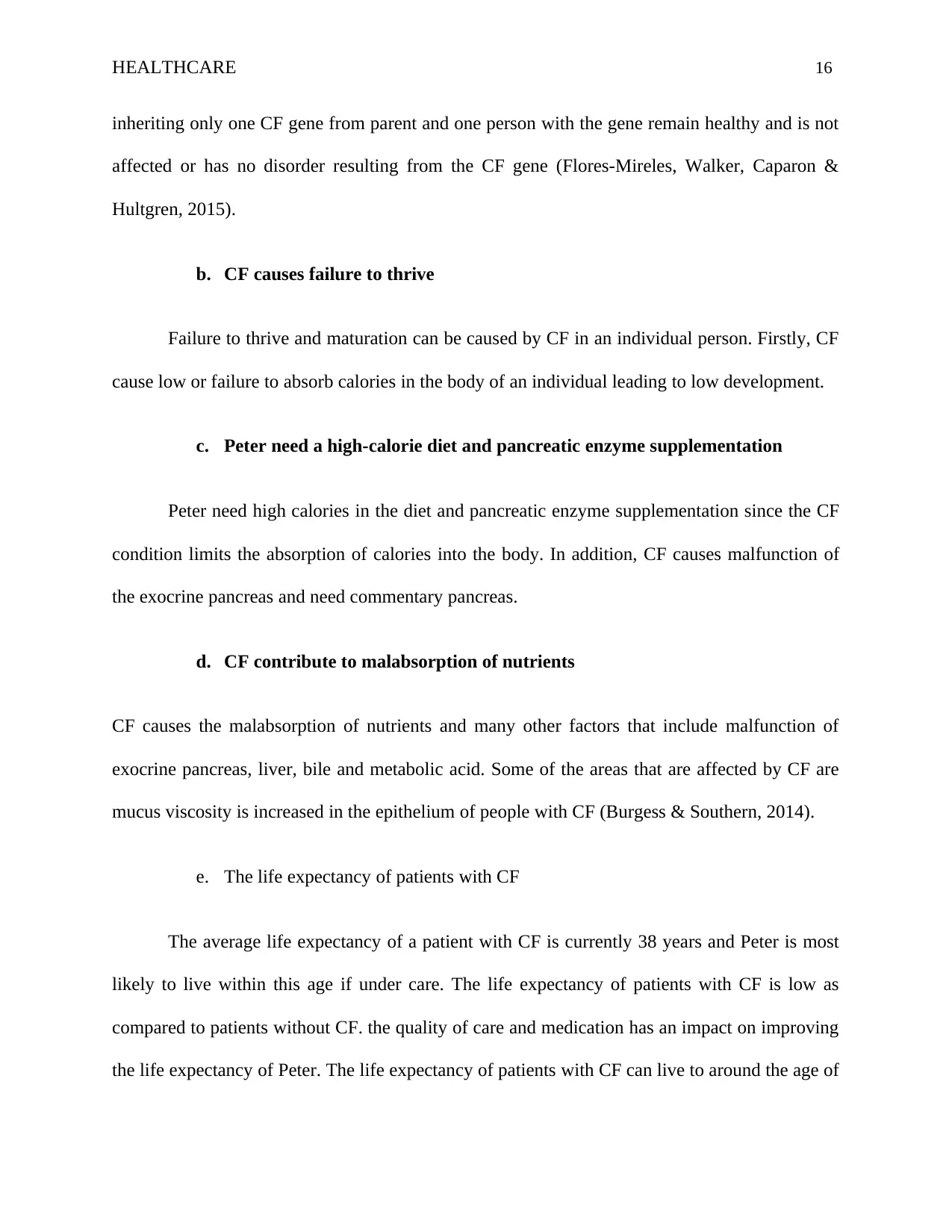
HEALTHCARE 16
inheriting only one CF gene from parent and one person with the gene remain healthy and is not
affected or has no disorder resulting from the CF gene (Flores-Mireles, Walker, Caparon &
Hultgren, 2015).
b. CF causes failure to thrive
Failure to thrive and maturation can be caused by CF in an individual person. Firstly, CF
cause low or failure to absorb calories in the body of an individual leading to low development.
c. Peter need a high-calorie diet and pancreatic enzyme supplementation
Peter need high calories in the diet and pancreatic enzyme supplementation since the CF
condition limits the absorption of calories into the body. In addition, CF causes malfunction of
the exocrine pancreas and need commentary pancreas.
d. CF contribute to malabsorption of nutrients
CF causes the malabsorption of nutrients and many other factors that include malfunction of
exocrine pancreas, liver, bile and metabolic acid. Some of the areas that are affected by CF are
mucus viscosity is increased in the epithelium of people with CF (Burgess & Southern, 2014).
e. The life expectancy of patients with CF
The average life expectancy of a patient with CF is currently 38 years and Peter is most
likely to live within this age if under care. The life expectancy of patients with CF is low as
compared to patients without CF. the quality of care and medication has an impact on improving
the life expectancy of Peter. The life expectancy of patients with CF can live to around the age of
inheriting only one CF gene from parent and one person with the gene remain healthy and is not
affected or has no disorder resulting from the CF gene (Flores-Mireles, Walker, Caparon &
Hultgren, 2015).
b. CF causes failure to thrive
Failure to thrive and maturation can be caused by CF in an individual person. Firstly, CF
cause low or failure to absorb calories in the body of an individual leading to low development.
c. Peter need a high-calorie diet and pancreatic enzyme supplementation
Peter need high calories in the diet and pancreatic enzyme supplementation since the CF
condition limits the absorption of calories into the body. In addition, CF causes malfunction of
the exocrine pancreas and need commentary pancreas.
d. CF contribute to malabsorption of nutrients
CF causes the malabsorption of nutrients and many other factors that include malfunction of
exocrine pancreas, liver, bile and metabolic acid. Some of the areas that are affected by CF are
mucus viscosity is increased in the epithelium of people with CF (Burgess & Southern, 2014).
e. The life expectancy of patients with CF
The average life expectancy of a patient with CF is currently 38 years and Peter is most
likely to live within this age if under care. The life expectancy of patients with CF is low as
compared to patients without CF. the quality of care and medication has an impact on improving
the life expectancy of Peter. The life expectancy of patients with CF can live to around the age of
Secure Best Marks with AI Grader
Need help grading? Try our AI Grader for instant feedback on your assignments.
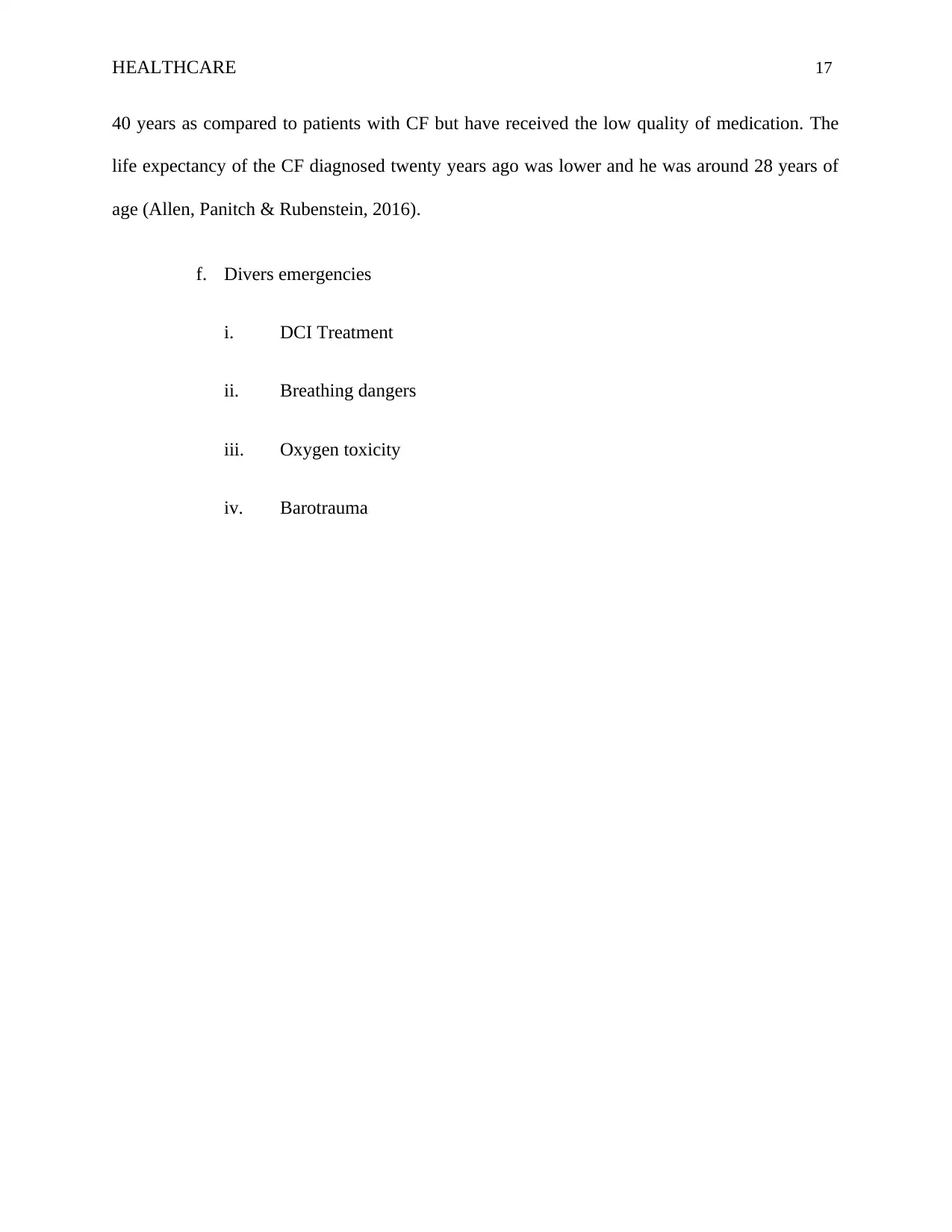
HEALTHCARE 17
40 years as compared to patients with CF but have received the low quality of medication. The
life expectancy of the CF diagnosed twenty years ago was lower and he was around 28 years of
age (Allen, Panitch & Rubenstein, 2016).
f. Divers emergencies
i. DCI Treatment
ii. Breathing dangers
iii. Oxygen toxicity
iv. Barotrauma
40 years as compared to patients with CF but have received the low quality of medication. The
life expectancy of the CF diagnosed twenty years ago was lower and he was around 28 years of
age (Allen, Panitch & Rubenstein, 2016).
f. Divers emergencies
i. DCI Treatment
ii. Breathing dangers
iii. Oxygen toxicity
iv. Barotrauma
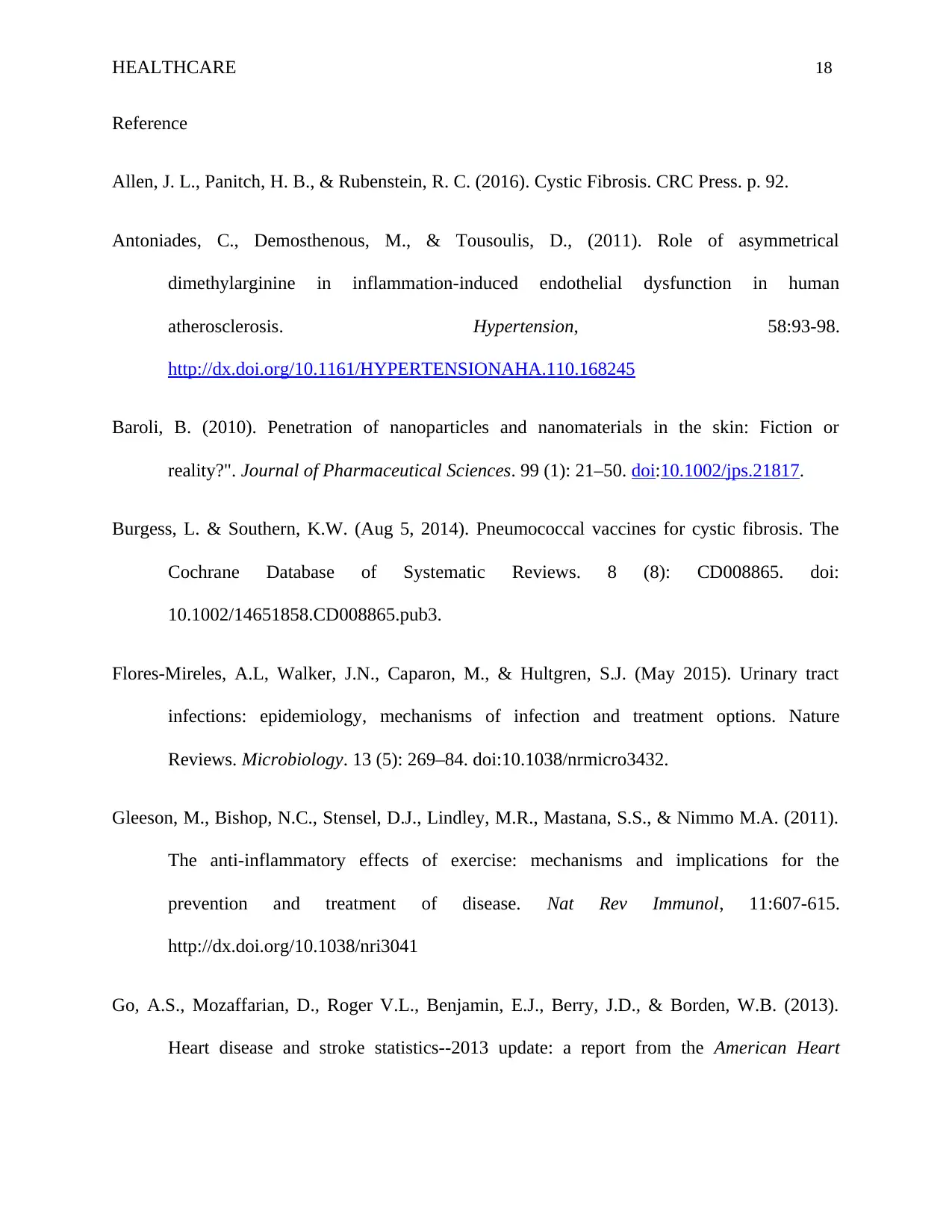
HEALTHCARE 18
Reference
Allen, J. L., Panitch, H. B., & Rubenstein, R. C. (2016). Cystic Fibrosis. CRC Press. p. 92.
Antoniades, C., Demosthenous, M., & Tousoulis, D., (2011). Role of asymmetrical
dimethylarginine in inflammation-induced endothelial dysfunction in human
atherosclerosis. Hypertension, 58:93-98.
http://dx.doi.org/10.1161/HYPERTENSIONAHA.110.168245
Baroli, B. (2010). Penetration of nanoparticles and nanomaterials in the skin: Fiction or
reality?". Journal of Pharmaceutical Sciences. 99 (1): 21–50. doi:10.1002/jps.21817.
Burgess, L. & Southern, K.W. (Aug 5, 2014). Pneumococcal vaccines for cystic fibrosis. The
Cochrane Database of Systematic Reviews. 8 (8): CD008865. doi:
10.1002/14651858.CD008865.pub3.
Flores-Mireles, A.L, Walker, J.N., Caparon, M., & Hultgren, S.J. (May 2015). Urinary tract
infections: epidemiology, mechanisms of infection and treatment options. Nature
Reviews. Microbiology. 13 (5): 269–84. doi:10.1038/nrmicro3432.
Gleeson, M., Bishop, N.C., Stensel, D.J., Lindley, M.R., Mastana, S.S., & Nimmo M.A. (2011).
The anti-inflammatory effects of exercise: mechanisms and implications for the
prevention and treatment of disease. Nat Rev Immunol, 11:607-615.
http://dx.doi.org/10.1038/nri3041
Go, A.S., Mozaffarian, D., Roger V.L., Benjamin, E.J., Berry, J.D., & Borden, W.B. (2013).
Heart disease and stroke statistics--2013 update: a report from the American Heart
Reference
Allen, J. L., Panitch, H. B., & Rubenstein, R. C. (2016). Cystic Fibrosis. CRC Press. p. 92.
Antoniades, C., Demosthenous, M., & Tousoulis, D., (2011). Role of asymmetrical
dimethylarginine in inflammation-induced endothelial dysfunction in human
atherosclerosis. Hypertension, 58:93-98.
http://dx.doi.org/10.1161/HYPERTENSIONAHA.110.168245
Baroli, B. (2010). Penetration of nanoparticles and nanomaterials in the skin: Fiction or
reality?". Journal of Pharmaceutical Sciences. 99 (1): 21–50. doi:10.1002/jps.21817.
Burgess, L. & Southern, K.W. (Aug 5, 2014). Pneumococcal vaccines for cystic fibrosis. The
Cochrane Database of Systematic Reviews. 8 (8): CD008865. doi:
10.1002/14651858.CD008865.pub3.
Flores-Mireles, A.L, Walker, J.N., Caparon, M., & Hultgren, S.J. (May 2015). Urinary tract
infections: epidemiology, mechanisms of infection and treatment options. Nature
Reviews. Microbiology. 13 (5): 269–84. doi:10.1038/nrmicro3432.
Gleeson, M., Bishop, N.C., Stensel, D.J., Lindley, M.R., Mastana, S.S., & Nimmo M.A. (2011).
The anti-inflammatory effects of exercise: mechanisms and implications for the
prevention and treatment of disease. Nat Rev Immunol, 11:607-615.
http://dx.doi.org/10.1038/nri3041
Go, A.S., Mozaffarian, D., Roger V.L., Benjamin, E.J., Berry, J.D., & Borden, W.B. (2013).
Heart disease and stroke statistics--2013 update: a report from the American Heart
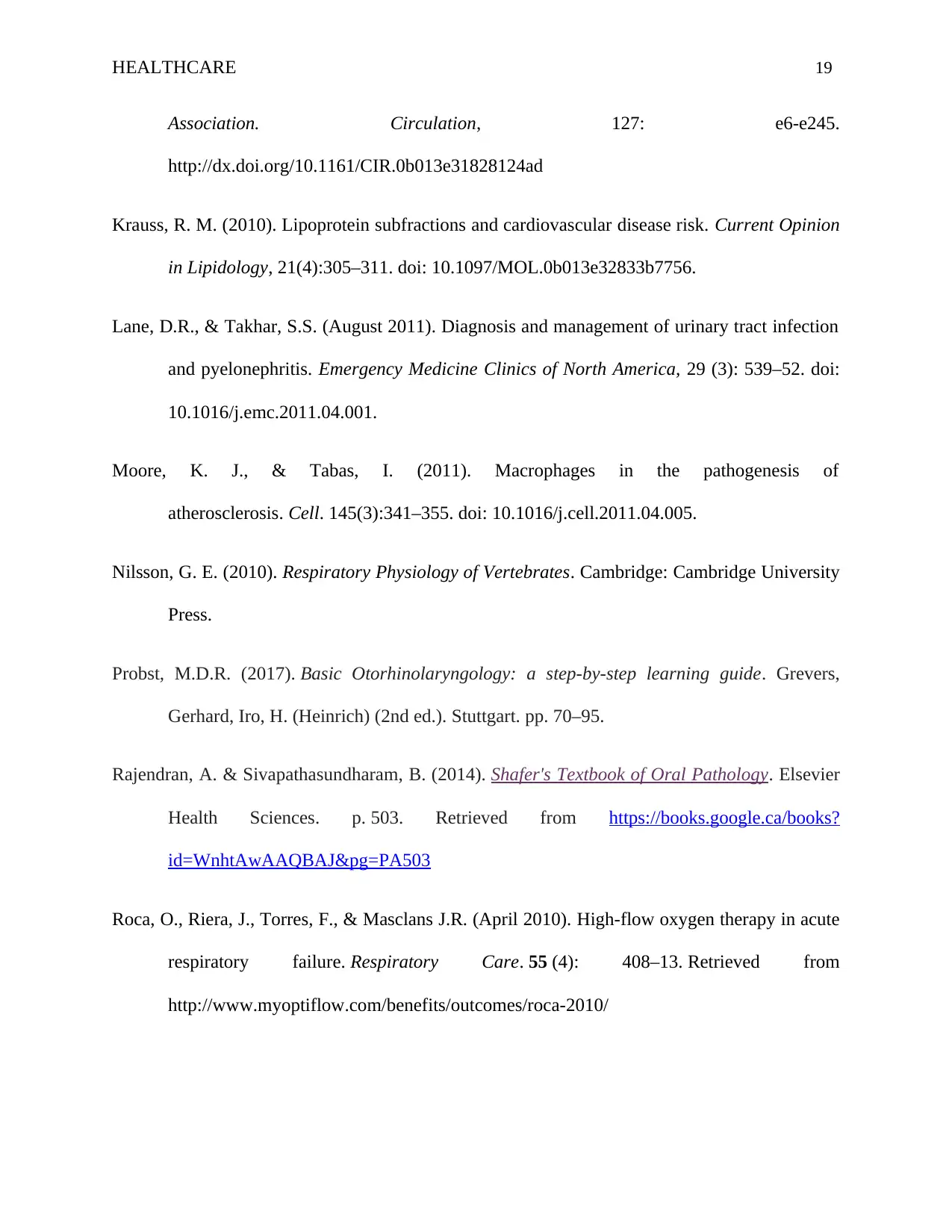
HEALTHCARE 19
Association. Circulation, 127: e6-e245.
http://dx.doi.org/10.1161/CIR.0b013e31828124ad
Krauss, R. M. (2010). Lipoprotein subfractions and cardiovascular disease risk. Current Opinion
in Lipidology, 21(4):305–311. doi: 10.1097/MOL.0b013e32833b7756.
Lane, D.R., & Takhar, S.S. (August 2011). Diagnosis and management of urinary tract infection
and pyelonephritis. Emergency Medicine Clinics of North America, 29 (3): 539–52. doi:
10.1016/j.emc.2011.04.001.
Moore, K. J., & Tabas, I. (2011). Macrophages in the pathogenesis of
atherosclerosis. Cell. 145(3):341–355. doi: 10.1016/j.cell.2011.04.005.
Nilsson, G. E. (2010). Respiratory Physiology of Vertebrates. Cambridge: Cambridge University
Press.
Probst, M.D.R. (2017). Basic Otorhinolaryngology: a step-by-step learning guide. Grevers,
Gerhard, Iro, H. (Heinrich) (2nd ed.). Stuttgart. pp. 70–95.
Rajendran, A. & Sivapathasundharam, B. (2014). Shafer's Textbook of Oral Pathology. Elsevier
Health Sciences. p. 503. Retrieved from https://books.google.ca/books?
id=WnhtAwAAQBAJ&pg=PA503
Roca, O., Riera, J., Torres, F., & Masclans J.R. (April 2010). High-flow oxygen therapy in acute
respiratory failure. Respiratory Care. 55 (4): 408–13. Retrieved from
http://www.myoptiflow.com/benefits/outcomes/roca-2010/
Association. Circulation, 127: e6-e245.
http://dx.doi.org/10.1161/CIR.0b013e31828124ad
Krauss, R. M. (2010). Lipoprotein subfractions and cardiovascular disease risk. Current Opinion
in Lipidology, 21(4):305–311. doi: 10.1097/MOL.0b013e32833b7756.
Lane, D.R., & Takhar, S.S. (August 2011). Diagnosis and management of urinary tract infection
and pyelonephritis. Emergency Medicine Clinics of North America, 29 (3): 539–52. doi:
10.1016/j.emc.2011.04.001.
Moore, K. J., & Tabas, I. (2011). Macrophages in the pathogenesis of
atherosclerosis. Cell. 145(3):341–355. doi: 10.1016/j.cell.2011.04.005.
Nilsson, G. E. (2010). Respiratory Physiology of Vertebrates. Cambridge: Cambridge University
Press.
Probst, M.D.R. (2017). Basic Otorhinolaryngology: a step-by-step learning guide. Grevers,
Gerhard, Iro, H. (Heinrich) (2nd ed.). Stuttgart. pp. 70–95.
Rajendran, A. & Sivapathasundharam, B. (2014). Shafer's Textbook of Oral Pathology. Elsevier
Health Sciences. p. 503. Retrieved from https://books.google.ca/books?
id=WnhtAwAAQBAJ&pg=PA503
Roca, O., Riera, J., Torres, F., & Masclans J.R. (April 2010). High-flow oxygen therapy in acute
respiratory failure. Respiratory Care. 55 (4): 408–13. Retrieved from
http://www.myoptiflow.com/benefits/outcomes/roca-2010/
Paraphrase This Document
Need a fresh take? Get an instant paraphrase of this document with our AI Paraphraser
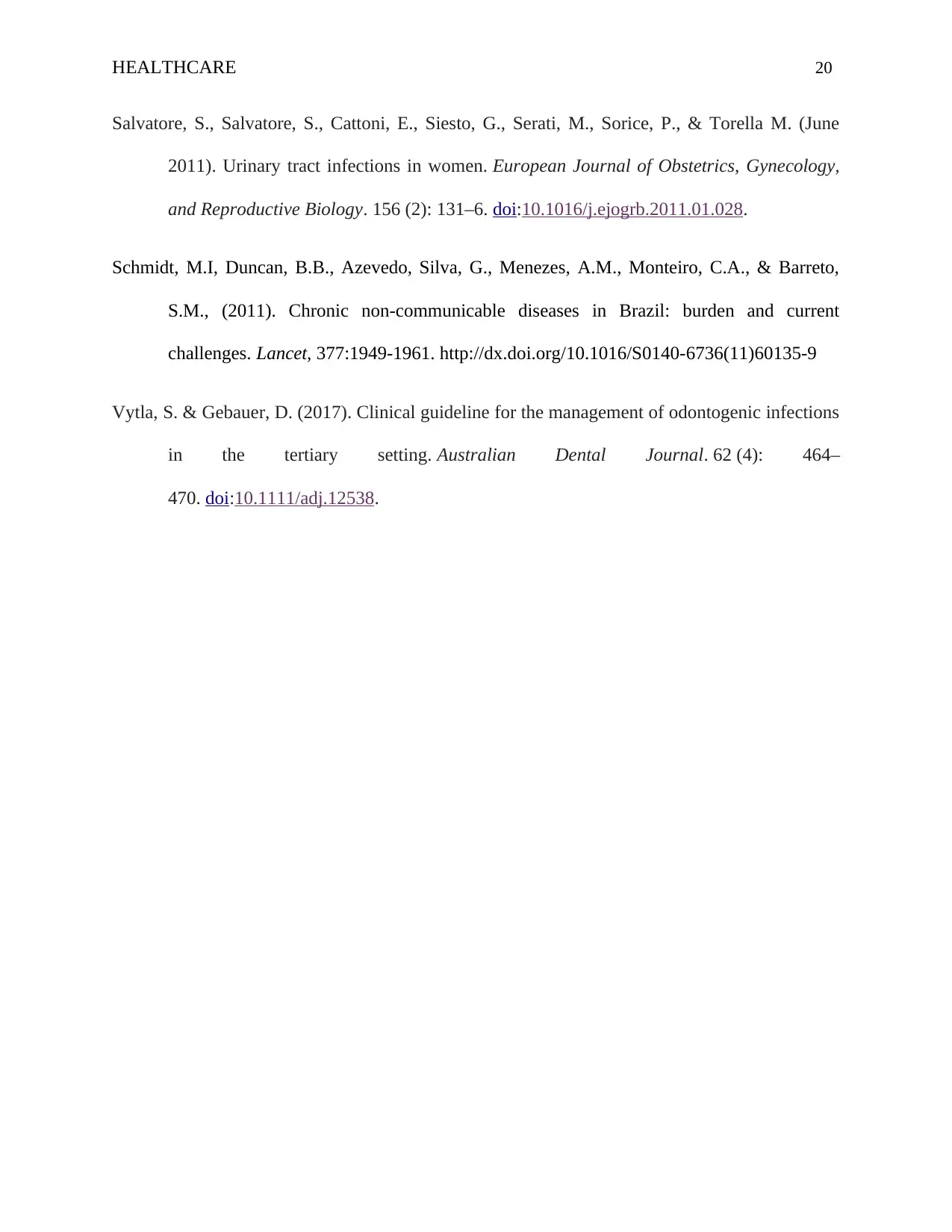
HEALTHCARE 20
Salvatore, S., Salvatore, S., Cattoni, E., Siesto, G., Serati, M., Sorice, P., & Torella M. (June
2011). Urinary tract infections in women. European Journal of Obstetrics, Gynecology,
and Reproductive Biology. 156 (2): 131–6. doi:10.1016/j.ejogrb.2011.01.028.
Schmidt, M.I, Duncan, B.B., Azevedo, Silva, G., Menezes, A.M., Monteiro, C.A., & Barreto,
S.M., (2011). Chronic non-communicable diseases in Brazil: burden and current
challenges. Lancet, 377:1949-1961. http://dx.doi.org/10.1016/S0140-6736(11)60135-9
Vytla, S. & Gebauer, D. (2017). Clinical guideline for the management of odontogenic infections
in the tertiary setting. Australian Dental Journal. 62 (4): 464–
470. doi:10.1111/adj.12538.
Salvatore, S., Salvatore, S., Cattoni, E., Siesto, G., Serati, M., Sorice, P., & Torella M. (June
2011). Urinary tract infections in women. European Journal of Obstetrics, Gynecology,
and Reproductive Biology. 156 (2): 131–6. doi:10.1016/j.ejogrb.2011.01.028.
Schmidt, M.I, Duncan, B.B., Azevedo, Silva, G., Menezes, A.M., Monteiro, C.A., & Barreto,
S.M., (2011). Chronic non-communicable diseases in Brazil: burden and current
challenges. Lancet, 377:1949-1961. http://dx.doi.org/10.1016/S0140-6736(11)60135-9
Vytla, S. & Gebauer, D. (2017). Clinical guideline for the management of odontogenic infections
in the tertiary setting. Australian Dental Journal. 62 (4): 464–
470. doi:10.1111/adj.12538.
1 out of 20
Your All-in-One AI-Powered Toolkit for Academic Success.
+13062052269
info@desklib.com
Available 24*7 on WhatsApp / Email
![[object Object]](/_next/static/media/star-bottom.7253800d.svg)
Unlock your academic potential
© 2024 | Zucol Services PVT LTD | All rights reserved.

